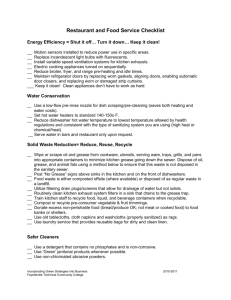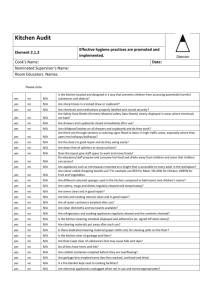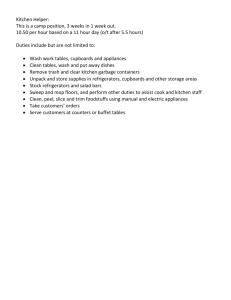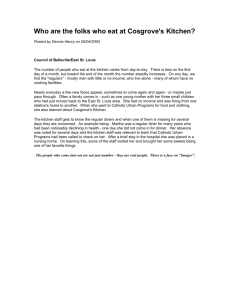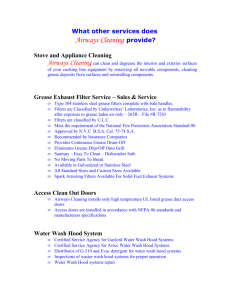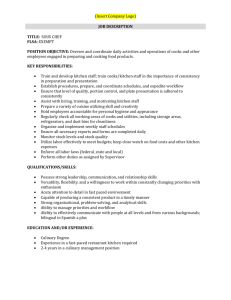Kitchen Design Guide
advertisement
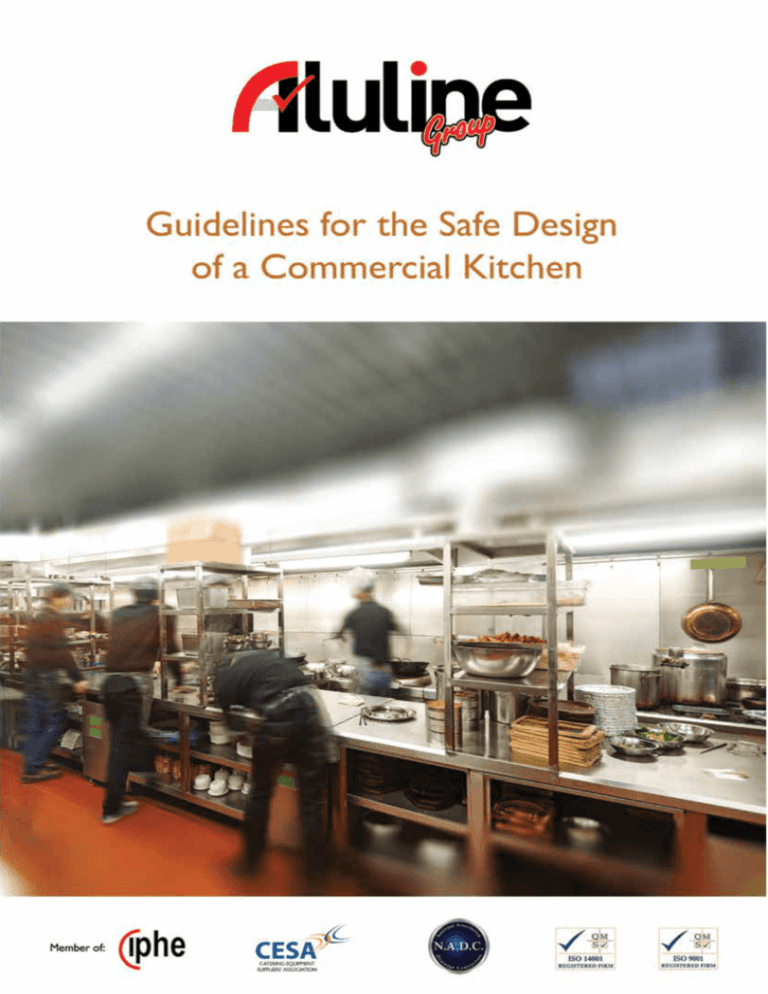
p2 Index Section Title Introduction ........................................................................................................................................................ Work Space Dimensions ............................................................................................................................. Kitchen Flow Chart ........................................................................................................................................ Kitchen Equipment requiring Grease Management Systems ................................................ Page 4 Page 5 Page 6 Page 7 1 1.1 1.2 1.3 Spatial Planning Spatial requirements ...................................................................................................................................... Work Flow ........................................................................................................................................................... Provisions for adequate space ................................................................................................................. Page 8 Page 8 Page 9 2 2.1 2.2 Food Safety Temperature Measuring Devices ........................................................................................................... Food handling ..................................................................................................................................................... Page 10 Page 10 3 3.1 3.2 Water Supply and Drainage Water supply ...................................................................................................................................................... Drainage ................................................................................................................................................................ Page 11 Page 11 - 21 4 4.1 4.2 4.3 4.4 4.5 Fixtures, Fittings and Equipment General requirements ................................................................................................................................... Installation ............................................................................................................................................................ Specificrequirements.................................................................................................................................... Materials ................................................................................................................................................................ Cleaning sanitizing and maintenance ................................................................................................... Page 22 Page 22 Page 23 Page 23 Page 23 - 25 5 5.1 5.2 5.3 5.4 5.5 Waste Disposal systems .............................................................................................................................................. Storage ................................................................................................................................................................... Location ................................................................................................................................................................. Flooring .................................................................................................................................................................. Cleaning ................................................................................................................................................................. Page 26 - 27 Page 27 - 28 Page 28 Page 28 Page 28 6 6.1 6.2 6.3 Flooring Floorfinishesandserviceability.............................................................................................................. Floor drainage .................................................................................................................................................... Floor and wall intersections ...................................................................................................................... Page 29 Page 29 Page 29 7 7.1 7.2 Walls and Ceilings Ceilings ................................................................................................................................................................... Walls ........................................................................................................................................................................ Page 30 Page 30 8 8.1 8.2 8.3 8.5 Ventilation Natural ventilation .......................................................................................................................................... Exhaust systems ................................................................................................................................................ Airflowplananddesign................................................................................................................................ Environmental considerations .................................................................................................................. Page 31 Page 31 Page 32 Page 32 p3 Index Section p4 Title 9 9.1 9.2 9.3 9.4 9.5 9.6 Lighting General Requirements .................................................................................................................................... Natural&ArtificialLighting........................................................................................................................ Reflectance............................................................................................................................................................ Light Fitting Considerations ....................................................................................................................... Emergency Lighting .......................................................................................................................................... Environmental Considerations ................................................................................................................. Page 33 Page 33 Page 33 Page 34 Page 34 Page 34 10 10.1 10.2 Storage Storage Requirements .................................................................................................................................... HazardousSubstances.................................................................................................................................... Page 35 Page 35 11 11.1 11.2 11.3 Pest Control Prevention ............................................................................................................................................................. Insect Control ..................................................................................................................................................... Monitoring ............................................................................................................................................................. Page 36 Page 37 Page 37 12 12.1 12.2 12.3 Signage Emergency Signage ........................................................................................................................................... Hygiene Signage ................................................................................................................................................. Equipment Signage ............................................................................................................................................ Page 38 Page 38 Page 38 13 13.1 13.2 13.3 13.4 13.5 Staff Amenities Storage of Personal Items ............................................................................................................................ Changing Rooms ............................................................................................................................................... Toilets ....................................................................................................................................................................... StorageofOfficeMaterials .......................................................................................................................... Hand Wash Basins ............................................................................................................................................. Page 39 Page 39 Page 39 Page 39 Page 39 14 14.1 14.2 14.3 14.4 Fire Safety Emergency Procedures .................................................................................................................................. Emergency Devices .......................................................................................................................................... Fire Extinguishers ............................................................................................................................................ Staff Training for Emergencies .................................................................................................................... Page 40 Page 40 - 44 Page 41 Page 44 15 15.1 15.2 Access & Agress Provision for Egress ......................................................................................................................................... ProcessforPeoplewithDisabilities...................................................................................................... Page 45 Page 45 16 16.1 16.2 First Aid First Aid Kits ......................................................................................................................................................... First Aid Personnel Required ...................................................................................................................... Page 46 Page 46 Introduction Design points for Commercial Kitchens developed from our experience in kitchen design commercial drainage solutions with over 60 years experience. The aim of this guide is to provide the hospitality (including managers, proprietors, designers and commercial kitchen users) with recommendations for implementing efficient, safe and best practice for the hospitality industry. Within each section are precautions, processes and recommendations that contribute to the efficient running of a commercial kitchen, whether it is for small, medium or large premises. Theseguidelinescanbeusedwhendesigningnewkitchensorrenovatingexistingcommercialpremises. Theypresentthehospitalityindustrywithrecommendationsthatwillcontributetosafeandefficientproductionof uncontaminated food. They are guidelines only. The Law in your Kitchen Therewasatimewhenallchefshadtoworryaboutwascookinggoodfoodandmeetingthegrossprofittargeton topofkitchencosts.Chefsmustalsobeawareofthecurrentlegislationconcerningwastemanagementinhiskitchen. IntheUK,themostimportantfoodhygieneregulationsforyourbusinessare: •Regulation(EC)No.852/2004onthehygieneoffoodstuffs. •TheFoodHygiene(England)Regulations2006(asamended) (andequivalentregulationsinScotland,Wales&NorthernIreland). •TheBuildingAct1984. •FoodSafetyAct2006. •EnvironmentalProtectionAct1990. •WaterIndustryAct1999. Notonlymustthechefbeawareoftheseregulations,theymustmakesuretheirpremisesandstaffcomplieswith these regulations. CE Marking Thisisthesmall“CE”badgethatallpoweredcateringequipmentsoldintheUKandEuropemustcarry.Itmeans thatthemanufacturerhascertifiedthatitmeetsEuropeanUnionsafetyand,insomecases,performancestandards. The EU standards are among the strictest in the world and are drawn up to ensure that kitchen staff have the least possibleriskofinjury. ReputablebrandsofcateringequipmentboughtfromreputabledealersshouldalwayshavetheCEmark,butoccasionally thereisequipmentofferedforsalewhichlooksthepartbutlacksthatall-importantCEbadge.Theregulationrecognizes that many kitchens have well-maintained old equipment that predates the introduction of CE marking. That is why the legalrequirementforkitchenequipmenttobeCEmarkedappliesonlytoequipmentmanufacturedafter1995. p5 Work Space Dimensions Itisrecommendedthatprovisionbemadeforthefollowing: Clearances •Upto1200mmclearanceinfrontofstorageareaswithaslidingdoor. •1200mmx1200mmclearanceinfrontofotherroomswithswingingorfoldingdoors(i.ediningroom/servicedoors). •Betweenworksurfaces900mm. Suggested Layout Thisisasuggestedlayoutforalargekitchenservicingarestaurant.Thelayoutcanbemodifiedtosuitsmallkitchens,pubsandclubs or expanded to suit larger commercial kitchens. Steam Oven Grease Trap Combi Oven Waste Pipe Meat Poultry Grease Trap Fish Cold Stores Cooking Equipment Quadwash Service Counter Vegetables Cooking Area Prep Area Undercounter Refrigeration Beverage Janitorial Stores Waiter Traffic Storage Area Quadwash Quadwash Service Door Wash Area Dish Washing Crockery Stores Grease Trap Dry Stores Pot Wash Dish Washer Potato Peeler Laundry Room Outside Yard Lint Separator Washing Machines Starch Separator Potato Peeler Bins Bins Gully Ironing Bunding Dryer Allequipmentconnectedtowasteshouldbetrappedandranthrougha Grease Management System. Grease Management System required if the area is used to wash down equipment Note:Thearea3,5&7shouldbeseparateandnotcrossoverintheflowdesignofakitchen. p7 Macerators should not discharge into the drainage system. A separate collection tank for this waste is required. Adrainfromthistankisadvisable.Pleaserefertopage12(designconsiderations)forfurtherinformation. p8 Section 1 Spatial Planning This section sets out criteria for the spatial planning of commercial kitchens. A well-planned kitchen will save time and effort in food preparation and reducing cross contamination while create a safe work environment. 1.1 Spatial Requirements Awellplannedkitchenshould: •Provideadequatestorageforrawmaterials. •Provideadequatespaceforfoodbeingprepared. •Provideadequatespacefoodawaitingservice. •Provideadequatestorageforequipment,utensils,crockeryandcutlery. •Beefficientandeffectiveintermsofmovementofstaff,equipment,materialsandwastemanagementsysteminplace Food,Oil&Grease(F.O.G) •Provideanareaforcheckinginstock. •Janitorialstoreforkitchen,withjanitorialsinkinplaceandchemicalstore. Tomaintaineffectivemovementthroughspaces,theareaperpersonaccordingtouseoftheequipmenthasbeenestablished bytheBuildingAct1984/Workplace(Health,SafetyandWelfare)Regulations1992.Itisrecommendedthatinakitcheneach person needs 10m2. 1.2 Work Flow Thepremisesshallbedesignedsothatthereisacontinuousprogressionoffoodfromdeliverytostorage,throughto preparationandthefinishedproduct,withnocrossovertoavoidcrosscontamination. 1.2.1 Food Delivery or Receiving Thisincludesthereceivingofpurchasedgoods,whichinvolves:handling,checking,recordingorstorage. Someofthesefunctionsmaybecombinedornotneededdependingonthesizeofthekitchen. 1.2.2 Storage Theamountofstoragespaceandthetypeofstoragewilldependon: •Thesizeofthekitchen. •Menu. •Thevolumeofbusiness. •Deliveryfrequency. •Thelengthofstorage. •Thetypeofstorage(frozen,refrigeratedordry). Storageofmeats,poultryandfishshouldbetakenintoconsiderationwhendesigningthekitchenandkeptseparate fromdryfoods,vegetables,fruitandpastry. 1.2.3 Preparation and Cooking Themainpreparationareasinfoodpremisesarefor: •Meatpreparation. •Poultrypreparation. •Fishpreparation. •Vegetablepreparation. •Pastry/dessertpreparation. Allfoodpreparationareasshouldbeseparatefromthecookingarea.Eachpreparationareashouldhaveonesingle sinkperstationseparatedbyaphysicalorairgaptoreducecrosscontamination.Handbasinsshouldbeinthese areas.(SeePage5) p9 Section 1 Spatial Planning 1.2.4 Clean Crockery Storageforcleancrockeryshouldbeclosetothewashingupfacilitytominimiseexcessmovementaroundthekitchen and ideally in a separate room due to the air pollution in a kitchen. 1.2.5 Food Service Thetypeofservice(alacarte,fastfood,caféorbanquet)willdirecthowtheservingfunctionisperformed.Themost common service is plate service, which requires pick-up points next to the cooking area.The pick-up point arrangement shouldhaveamethodtokeepthedisheswarm/cold. Thereshouldbeaseparatepick-uppointforchilledfoodsuchasdessertstobeheldinarefrigeratedcabinet.The pick-uppointarrangementiscriticalforanefficientinandoutflowofwaitertraffic.Itisessentialtodesignkitchen flowofservice/waiterstrafficinthekitchenlayout.Waitingstaffshouldnothaveeasyaccesstothecookingareaor preparation area. 1.2.6 Waste Food and Dirty Crockery The dish washing area positioning is vital to the successful operation of any kitchen. The design of the dish washing area should have a large drop off area. This area should have the facility to cope with the waste from plates. This will dependonthenumberofcoversandmenu. Thefollowingisasuggestedlistofpossiblecleaning/storingmethodsandequipment: •Stainlesssteelrackingforpotsandpans.Openforeaseofcleaning. •Stainlesssteelrackingforplatesinseparateenclosedarea. •Cutlerystorage. •Enclosedstorageformops,chemicalandjanitorialsink.Differentmopsfordifferentareas. •Adequatesinks.Whenpositioningsinks,drainageshouldbeaddressede.g.Sinksshouldbeinline,inorderto reducethenumberofGreaseTrapsrequired. •Pre-rinsehoseondirtysink. •Extractionsystem. •Wastedisposalbin(differingbinsforrecyclables). •WasteManagementSystem. •HACCP-Regulation(EC)No.852/2004onthehygieneoffoodstuffs. Food,Oil&Greasearebyproductsofthekitchenandcreatedrainageproblemsinkitchens.Thesesubstancescreate majorproblemsfortreatmentplants.Thebestmethodofcontrollingthisisatsource.Thisshouldbeaddressedat planningstagetopreventproblemsfromwatercompanies,environmentalagenciesandpublichealthinspectors. 1.3 Provisions for Adequate Space Spaceshallbeprovidedonthepremisesforstafftohandlefoodandperformotheractivitiesthatarepartofthefood business. Spaceshouldbeprovidedfor: •Staffchangingroom. •Foodpreparationandservice. •Separationofrawfoodpreparationfromcookedfoodpreparationandotherready-to-eatfoodpreparationareas. •Washingandsanitizingoperationsforutensilsandequipment. •Separationoffoodstorageandhandlingareasfromareasforchemicalstorage,toilets,wastestorage,officeareas and other areas used for activities that could contaminate food or food preparation areas. •F.O.Gmanagementsystems. Itisrecommendedthatwashhandbasinsshouldbelocatedatentryandexitpointsandinthedifferentareaswhere foodishandlede.g.betweenprepareaandcookingarea.Washhandbasinsshouldnotbeincludedinworktops. Theyshouldbeseparatedwithaphysicalorairgapinbetweentominimisecrosscontamination. p10 Section 2 Food Safety This section covers the food safety program, food handling controls such as food processing, food display, food packaging and transportation of food, as well as food handling. Glossary Food-borne disease: Food safety program: Potentially hazardous Food: Process: Ready-to-eat food: Temperature control: Adiseasethatislikelytobetransmittedthroughconsumptionof contaminated food. A program that is set out in a written document, and kept at the food premises, which includes records of compliance and other related actions. thathastobekeptatcertaintemperaturestominimizethegrowthof anypathogenicFood:micro-organismsthatmaybepresentinthefood or to prevent the formation of toxins in the food. The activity of preparing food for sale including chopping, cooking, drying, fermenting, heating, pasteurizing, thawing and washing, or a combinationoftheseactivities. Food that is consumed in the same state as that in which it is sold and does notincludenutsintheshellandwhole,rawfruitsandvegetablesthatare intendedforhulling,peelingorwashingbytheconsumer. Maintaining food at required temperatures. 2.1 Temperature Measuring Devices Temperaturesmustbetakenandrecorded(seeEHOorlocalcouncils). Atemperaturemeasuringdeviceneedstobereadilyaccessibleandmustaccuratelymeasurethetemperatureof foodto+/-1°C. •Thetemperatureofcoldfoodshouldbemaintainedat8°Celsius,orbelow. This is to minimise the growth of infectious or toxigenic micro-organisms in the food and so thatthesafetyofthefoodwillnotbeadverselyaffectedforthetimethefoodisatthattemperature. •Thetemperatureofhotfoodshouldbemaintainedat63°Celsiusorabove.Thefoodbusinessneedsto demonstrate that they can maintain food at that temperature for the required period of time and that it willnotinanywayaffectthemicrobiologicalsafetyofthefood. 2.2 Food Handling Staff must wash hands as they move from different area’s in the kitchen e.g. preparation to cooking. This will help reducecrosscontamination.Preparedmeats,poultry,fishandvegetablesmustberefrigerateduntilneededandheld inarefrigeratedundercounterunitinthecooking/preparea. Ideally •Usecolourcodedchoppingboardsandknivesforrawandready-to-eatfood. •Washyourhandsbeforepreparingfoodandafter. •Keeprawandready-to-eatfoodapartatalltimes. Anystaffsufferingfromdiarrhea/vomitingwithinhoursmustnotbeallowedintothekitchenareaunderany circumstance. Itmustbeassuredthatanystaffmemberignoringthissafetyrequirementcanbesubjecttoinstantdismissalalong with their manager for condoning this. Staff can only return to work two days after the symptoms have passed. p11 Section 3 Water Supply & Drainage This section refers to water supply and drainage in a commercial kitchen. The design and installation of water supply and drainage systems must comply with statutory requirements. Itisrecommendedthatqualifiedhydraulicengineersand/ortradespersonsareengagedtoensurecompliance. Glossary Non-potable water: Waterthatisnotsuitableforhumanconsumption(greywater). Bio-film: Itisthecoatingfoundinsidethewastepipeswherethebacteriathrive. 3.1 Water supply Watersupplyisrequiredforthefollowing: •Drinking. •Cooking. •Icemaking. •Cleaning. •Sanitizing. •Personalhygiene. •Firesuppressionsystems(firehydrants,hosereelsandsprinklersystems). Separatenon-potablewatersuppliesareoftenusedforfiresuppressionsystemse.g.recycledrainwater. Hotwatermustbestoredataminimumof60ºCtopreventgrowthofbacteriasuchasLegionella.(Seepage24). Waterpressuremustbeadequatetomeetallthedemandsofthecommercialkitchen. 3.2 Drainage Waste removal at source is a simple concept in a highly complex world. Ifwastewhichcanbedealtwiththroughcompostingorlandfillisnotintroducedintooursewagesystemstheloading on the system is reduced. Whenbestkitchenpracticesareappliedandadheredto,e.g.useofpaperwipestocleansurfacesandsprayapplications willeradicatetheintroductionofdisinfectantandsanitisersintothedrainagesystem.CapturingFOGbeforeitentersthe drainagesystemisthebestsolutionwhichAlulinehasbeenencouragingsitestodoforthepasttwentyyears.Biofilm whichiscreatedbyoil,suffocatestheaerobicbacteriaandthereforecanleadtoblockages,asthebacteriaisthecleaning agent for our waste water network. Bacteria are the key to a proper functioning drainage system.We are not referring to“commercialbacteria”dosedtoenhancedrainagesystemsbutthenaturalbacteriacontainedinalllivingorganisms. Theaerobicbacteriainpipesandtanksrequireoxygentocarryoutitsfunctionofdigestingorganicmaterialsflowing through pipe lines. •Theoxygensupplycanbedamagedbyexcessiveuseofchemicalsoroil(whichcontainsnooxygen)thiscan removetheoxygensupplycoatingpipesandorganicseffectivelykillingbacteriabyoxygenstarvation. •Thiscanbebestobservedinpumpingchamberswheresolidbuildupsformfloatingraftsordebriswhichwill notsinkasoileffectivelywaterproofsfloatingsolidsandbacterialactionisdramaticallyreduced. •Disposalofwastesolidandliquidformshavebecomeamajorprobleminmanycities.Thecostofsupplying services to this area of our life style is spiraling. Commercial kitchen management is well advised to ensure that the staff are aware of the need to reduce waste and how to dispose of it in a regulated manner. •CommercialkitchendesignersandarchitectshaveadutyofcaretotheirclientsandshouldincludeFood, Oil&Grease(F.O.G)managementintheirdesigns. Authoritiesandmunicipalitiesareimposingchargesandfinesonpolluterswhichareunlimited. Inenvironmentalsituationsclaimsof‘ignorance’arenolongeradefence,chargesandfineswillbeimposedpluscosts oneverypolluter.Simpleactionssuchasmakingsuresinkfiltersaresuppliedandused,oilandoilbasedproductsare notdisposedofintowasteoutlets,sanitizersarenotputintosinksortoiletoutlets,handwashisdonebythreestage process, i.e. soap wash, dry and sanities. p12 Section 3 Water Supply & Drainage Simply if oils and sanitizers are excluded from drainage many problems will not require remediation. A management plan for drainage and grease traps including a record cardtoshowcleaningscheduleshouldbeincludedinanykitchen risk analysis. In accordance with current guidance from UK Water Companies, Dishwashersandwastedisposalunitsshouldnotbeconnectedto grease separators. Grease Traps Grease Traps must be sized for each site and each unit that is to be fitted to and they must have odour tight lids/airtight to stop air bourne bacteria contaminating preparation / cooking surfaces. SurfacemountedGreaseInterceptorsshouldbepositionedtoallowaccessformaintenance(andcleaning).Unitsare fittedtogreaseproducingequipmentwithinthekitchentostopFOG(Food,oilandgrease)fromenteringdrainage system.Interceptorsshouldbepositionedatleast50mmfromwallsforcleaning.A5ampfusedspurisrequiredfor installationofthedosingsystem.ElectricalcontractorsshouldbeconsultedtodeterminewhetherthisshouldbeIP rated.Althoughitiscommonplacetofitinterceptorsbeneathasinkdrainer,theycanbeinstalledinanypositionon thepiperunwherespaceisavailable,(Arecommendedlidclearanceofaround250mmisrequiredtoallowaccessfor maintenance).Kitchendesignersshouldrecognizetheneedtospecifyfabricationdesigntoaccommodatethetraps particularlyinundersinklocationsi.e.noundershelfandtiebarstoextremitieswheredimensionsarecritical. Bioremediation Whereverpractical,dosingshouldbefittedattheheadofthedrainagerun.Tubingconnectionisintothetopofthe wastepipeusingsuppliedfittings.Theentrypointisviapipeworkwithdirectaccesstotheinterceptor.Whendosing anoutdoortrap,entrypointshouldbewithinthekitchenattheheadofthedrainagerun. Design Considerations •Scrapping/Pre-rinsespraysinks(highestvolumeofwastefromthissink). •Panwash/Dirtysinkproducesfood,oil&greasewaste. •SteamingandcombinationovenstobetrappedduetotheamountofFOGtheycanproduce. •Butchersprepsinksproducegrease. •Bakerssink(wherepiesorsavoriesareprepared,theyproducefood,oil&grease). •Sinkswherecream,milk,mayonnaiseorsaladdressingsareused,theyproducefood&oil. •Thebiggerthebetter(largertrap=largersettlementarea,morewater,oxygenandsurfaceareafor biologicalactiontooccur). •Biologicalvs.Traditional(Smallvs.Largecapacity). •Biologicalvs.Mechanical(Sustainablevs.Replaceable). •FloorGullies/ChannelsconnectedtoUGgreasetrap(Wastepipesfromsinksshouldbeconnectedto sealeddrainageconnectionswithroddingaccess). •PotatoPeelersshouldbeputthroughaStarchSeparator. •Wastedisposalunitsshouldbepipedintoawastefoodcollector.Thisshouldnotbeintroducedintothe drainagesystem.(theyarebannedinScotlandandthereisaconsultationdocumenttobringinabaninNIin2017. •BrattPans/TiltingKettles.TheseproduceF.O.G(GulliesshouldbeconnectedtoanUGtrap) •Washhandbasins(useplainsoapandseparatesanitizerforhands). •WokRanges(Theyproduceoilandfoodwastetrappedatsource). •YardGullies(GreaseManagementSystem(GMS)requiredifareaisusedtowashdownequipment). •SinkFilters(reduceeffluentintrapsandpipes). •ForUGunits,coverloadings/floorcoveringsmustbeconsidered. •HACCP-Regulation(EC)No.852/2004onthehygieneoffoodstuffs. p13 Section 3 Sizing of Grease Traps Dishwashers should not be connected through traps, as this can result in an emulsification of contents reducing efficiency. Interceptors installed outside or underground should be specified as one size larger than the AG equivalent (to allow for an extended maintenance period). Alulinewillprovideyouwithcompletespecificationforyourconsideration.Ideallythisshouldbe implementedatdesignstagewhethernewbuildorretro-fit. Constructingtailormadesolutions.Ourservicesareentirelybespokeandbasedonindividualdeliveryplansforeach premisesorproject,weproducesitesurveystoensureyourunderstanding. your understanding. Sizing Biological Grease Separators In accordance with current guidance from Water Authorities, dishwashersandwastedisposalunitsshouldnotbeconnectedto grease separators. Sizing for Above Ground Grease Traps Please refer to the chart on the relevant page for the grease trap sizes. To determine the size of grease trap, calculate the volume ofwater,dividebythedischargetime(2minutes). Example: Sink Size 2x400x400x(250),overflowheight(OH)is220. Volumeis2x400x400x220=70.4L Sink Size lx500x400x(300),overflowheight(OH)is220. Volumeis31x500x400x220=44.0L TotalVolume=114.40L Size of Grease Trap 114.4Ldividedbydischargetime(2Min)=57.2L UseAG2(115L)forAboveGroundSeries. Lcubicm=1tonne-1000L SinkSize(mm) Overflow Height(OH) Volume(Ltrs) 600 x 450 x 300 x 220 59.4 500 x 400 x 300 x 220 44 500 x 400 x 250 x 220 44 400 x 400 x 300 x 220 35.2 400 x 400 x 250 x 220 35.2 200 x 200 x 110 x 65 2.6 ThecalculationofGrease/OilInterceptorsizeisnotanexact science,factorstoaccountforare:typeofpremises,cleaning regime,stafftraining,frequencyofcleaning,availablespacefor fitting,placeoftrape.gabovefloor/belowfloorinsidekitchen outside kitchen. Supplier should have experience to advise on trap sizing, training & cleaning frequency. p14 The actual loading should be assumed to be 60% of the above value,asmostappliancesandfixturesarenotfilledtothebrim. Inmanycases,thesefixturesarefilledtolessthan60%ofthe capacity, especially when water is at premium. Most large businesses reduce water consumption to attain economic andenvironmentalbenefitsandreducecarbonfootprint. Sizing for Under Ground Grease Traps We use the same methodology for the Under Ground series (howeverasaruleofthumb)weadviseusingonesizelarger to reduce the cleaning regime. When specifying Under Ground Traps, the T-Dimension or invert level,itisimportanttoensurethatthelidisatafinishedleveland incrementcostcanbecalculatedforbillofquantities. Access to final position for cleaning is important during the specificationstage. Flow Rating A2minutedrainageperiodisacceptableforcommercialfittings tofullydischarge.Tocalculatetheflowrating,simplydividethe litrecapacityofthekitchenfixturesandequipmentby2(drainage period)togiveflowratinginlitres/minutethendivideby60to calculatelitres/second. Example: 59.4 litres multiplied by 0.60 to give actual loading for a single cateringsink=35.64litres.Thisisthendividedby2=17.83litres per minute or 0.297 litre per second. Under European Legislation, dishwashers are assumed to have flowrating2litres/second. Section 3 Sizing of Grease Traps The calculation of Grease/Oil Interceptor size is not a science. Factors to account for are: •Typepremises. •Cleaningregime. •Stafftraining. •Frequencyofcleaning. •Availablespaceforfitting. •Placingoftrape.g.abovefloor/belowfloor,insidekitchen-outsidekitchen. Suppliersshouldhaveexperiencetoadviseontrapsizing,training&cleaningfrequency.Theactualloadingshouldbe assumedtobe60%oftheabovevalue,asmostappliancesandfixturesarenotfilledtothebrim.Inmanycases,these fixturesarefilledtolessthan60%ofthecapacity,especiallywhenwaterisatpremium.Mostlargebusinessesreduced waterconsumptiontoattaineconomicandenvironmentalbenefitsandreducedcarbonfootprint. Inaddition,itisextremelyrarethatallfixturesandequipmentaredischargesimultaneously. Flow Rating Atwominutedrainageperiodisacceptableforcommercialfittingstofullydischarge.Tocalculatetheflowrating, simplydividethelitrecapacityofthekitchenfixturesandequipmentby2(drainageperiod)togiveflowratingin litresperminutethendivideby60tocalculatelitrespersecond. Example: 59.4litresmultipliedby0.60togiveactualloadingforasinglecateringsink=35.64litres Thisisthendividedby2=17.83litresperminuteor0.297litrespersecond. UnderEuropeanlegislation,dishwashersareassumedtohaveflowrating2litrespersecond (sourceBSEN1825-2) Bioremediation AsstatedinthePDIGuide“Theconceptofbioremediationissound,trapgreasesanddigeststhemintheinterceptor toconvertthegreasepermanentlyintotheby-productsofdigestion”. Thenormalby-productsofbioremediationarecarbondioxideandwater,producedasthebacteriainAluzymedosing systemsbegintodegradethedigestiblewastematerials. Thisisanimportantconsiderationwhensizinggreaseseparators,astheprocessallowssmallerunitstobeinstalled. Evenwhentheseparatorisoverloaded,theorganicmaterialcontainedwithiniscoatedbyabiofilm.Whenthese organicmaterialspassthroughthegreaseseparatortheyarecontinuallybeingdegradedastheyflowaway. Anotherkeybenefitofbioremediationisthattheprocessintroducesbacteriaintopipesystemsallowingadditional treatmenttotakeplace.Thebacteriacollectonanywetsurfaceandmultiply,resultinginabiofilmbeingcreated within the pipes. Selection of the Nominal Size For more guidance and information on selecting the nominal size for a grease separator and formula for calculating therequiredsize,pleaserefertoourcalculationfornominalsizehandbookattached. p15 Legislation Aluline recommends the use of grease separators to ensure that all your clients are fully compliant with current environmental legislation. According to Part H of the current edition of the Building Regulations in England and Wales, Drainage serving kitchens in commercial hot food premises should be fitted with a grease separator complying with BS EN1825-1, and designed in accordance with BS EN1825-2, or other effective means of grease removal. TheScottishBuildingStandardsareevenmoreexplicitintheircallforseparators,stating: Where a discharge into a drainage system contains oil, fat, grease or volatile substances, for example form a commercial kitchen, there should be facilities for the separation and removal of such substances. Separator systems are used in a wide variety of situations to fulfill a number of different requirements. It is important to establish why a separator system is needed and what specific function it is expected to fulfill before selecting the appropriate size and type of installation. Separators should be constructed and installed in accordance with the following draft European standards. A: BS EN 858-1: 2002 for light liquids such as oil or petrol B: BS EN 1825-2: 2002 for fat or grease Companies who advocate dosing systems without grease traps are effectively encouraging non-compliance in relation to theseregulations.Theyarguethatbydosingthedrains,clientsareadopting“othereffectivemeansofgreaseremoval”.In additiontotheregulationscurrentlyinplace,ifacommercialkitchenhasablockageorpollutesthedrainagesystem, therelevantauthorities’havethepowertofinetherestaurantoperators(andinextremecasestheindividualsworking withinthekitchens).Ifthatsitehasnogreaseseparatorinstalled,thentheyhavelittleornoprotectionfromthesefines andcharges(whichcanvaryfromhundredstothousandsofpoundsdependingontheseverityofthepollution.Therefore an installed and well maintained grease separator indicates to authorities that operators have used due diligence. In Practice Theideaofbiologicaldosingorbioremediationissound,andintheoryitcanbearguedtobeaneffectivesolution, however in practice, it has its limitations. In our experience, dosing as a stand alone solution does not work effectively. This is due to the amounts of food wastedischargedintothedrainagesystem,whichthebacteriacannotdigestinthetimeallowed.Someofthetypes orstrainsofbacteriausedinbiologicaldraindosingsolutionscandigestfoodparticles,buttheytakeaverylongtime to do so, and require the right conditions. Asecond,significantlimitationofdosingonlysystemsisthatthebacterialliquidsthattheydispenseintothedrains flowsdirectlyintothesewersystem.Thismeansthatthereisnothingbywayofretentiontimetoallowthebacteria to colonise within pipes. By the time the dosing liquids have reached a point within the drainage system where they cantreataretainedamountofwater(e.g.inamanholeorpumpingstation,otherpipeshavebranchedintothedrain run,andmoreoftenthannottransportantibacterialchemicalsfromhandwashbasins,orharshchemicalsfromfloor gullieswithinthewastewater.Thesechemicalsthenkillorretardthebacteriamakingthemmuchlessefficient. Intruth,biologicaldraindosingwouldbean“effectivemeansofgreaseremoval”ifnofoodwastewasdischargedinto thedrainagesystem(whichisunrealistic)andifnoanti-bacterialchemicalswerepresentinthedrainstokillthemoff orslowtheiraction(i.e.allstaffincateringestablishmentsadopteddrycleaningratherthanwetcleaningandonly usedpapertowelswhencleaningandsanitizing,ratherthanclothswhicharethenrinsedinsinks).Intherealworld thisisdifficulttoenforce. Youandyourclientsareawareoftheproblemsalso.FollowingrecentproblemsatasiteintheWestMidlandswhereno greasetrapwasinstalled,foodwaste,oilandgrease(FOG)collectedinthedrains(alongwithsomebuildingdebris)and causedthedrainstoblock,resultingintheneedtodigoutthedrainsatlargeexpense.Whileagreasetrapwouldnot havemadeanydifferenceinrespectofthebuilders’wastewithinthedrains,itmostcertainlywouldhaveassistedin thiscasebypreventingthequantitiesofFOGfromcollectinginthepipes. Oneofthebiggestproblemsfacingoperatorsisthattheperformanceofadosingsystemcannotbemeasured immediately.Forexample,itmaytakeaveryhighvolumesite6monthstoblockthedrains,whileinothersitesit could take three times as long. This can give the impression that a system is working when in fact it is not. p16 Grease Separator Systems Drainageservingkitchensincommercialhotfoodpremisesshouldbefittedwithagreaseseparatorcomplyingwith BSEN1825-1:2004anddesignedinaccordancewithBSEN1825-2:2002orothereffectivemeansofgreaseremoval. Thereasonsthatgreaseseparatorsystemshavebeenhistoricallyeffectivearesimple. •Theseparatorcatchesfoodwasteandretainsoilandgreasefortreatment,removalanddisposal. •Duetoitslocationwithinthepipesystem,thegreasetrappresentsabodyofwatertobedosed,allow retentiontimeforthebacteriatodigestthefatandgrease.Also,iflocatedcorrectly,thegreasetrapcanbe installedinapositionthatpreventslargequantitiesofantibacterialorotherharshchemicalsfromaffectingit (e.g.wherehandwashbasinsanddishwasherscanbeallowedtobypassthetraps). Inessenceagreasetrapallowsproblemareas(washupsinks,combiovensetc)tobeisolatedanddealtwith,all whilstbeingaboveground,sothatifablockageweretooccur,itisinaneasilyaccessibleareaandcanbedealtwith relatively cheaply and quickly. Weunderstandthatoperatorscanbecriticalofgreasetraps,findingthemunpleasanttomaintainattimes.Themost frequentcomplaintwegetisthattheysmellorbecomeblocked,andbothoftheseproblemsaredirectlyattributed toexcessfoodwastebeingcollectedwithinthem.Theeasiestthingtodoistoaskyourself,“Ifthegreasetrapwas not present, where would all of that food waste go?” Biological Grease Traps Thereasonsfordosinggreasetrapsarethreefold: •Usingbacteriainthegreasetrapsassiststhebreakdownoffatandgreasemakingthetrapmoreefficient,but this is due to the retention time that the trap affords. •Asthegreasetrapismademoreeffectivebyincludingdosing,asmallerunitcanbeusedwhenusingdosing (GreaseTraps)whichallowscompliancewithBSEN1825-1:2004. •Thebacteriawithinthegreasetraphelpstopreventthebuildupofanaerobicbacteria(whichcreatethe foulestodours)resultinginanimprovementintheodourswhenmaintenanceisrequiredandthelidsor covers are removed. Benefits of Aluline Equipment and Service AllAlutrapabovegroundgreaseseparatorsaremanufacturedanddesignedtobeairtight,topreventairbornebacteria escapingfromthetrap.Thisensuresthat(solongasthesealsareintact)noodoursorwatercanescapeintothekitchen. Our separators are made this way to satisfy environmental health concerns and prevent any contamination within the kitchens. Aluline’s policy of training staff when commissioning new installations ensures that operators not only know how to maintaintheequipment,butalsohowtoassesswhenitisrequired.Ourengineersthenprovideareactiveserviceto supplementthistraining.Also,byprovidingahealth&safetyapprovedcleaningkit,staffcanmaintaintheequipment in a safe manner and prevent cross contamination within the kitchen. p17 Section 3 Grease Trap Comparative Analysis Aluline Grease Trap Advantages 4 4 4 Aluline Interceptors are environmentally designed to prevent and stop excess food, oil and grease from entering the drain system through it’s waste treatment at source technology. Biological treatment of retained food, oil and grease in an interceptor will reduce the frequency of maintenance. TheAluzyme’sbiologicalactionactivatesthebacteriato bedegradeanddigestthewasteintoH2OandCo2inthe tank and enhances the performance of pipeline systems and waste treatment tanks. 4 Pipelines running several meters from the food production area to the main manhole or the pumping stationsremaincleanandtroublefree. 4 Easytomaintainandcleanbyclient/serviceengineeras per Aluline service training provided during installation and routine follow ups. 4 4 Stainless steel and air tight design plus the training given on hygieneallowsalulinetrapstobefittedinthewashupareas inkitchenandtheundergroundfloormountedgreasetraps donotoverflow. Aluline cleaning systems allows the solid waste from these trapstobeplacedinclientswasteskips Mechanical Devices Disadvantages 7 7 7 7 4 4 Alulinegreasetrapsareeasytoinstallandbecomesthe responsibilityofthekitchenchefandtheservicemanager who are actually generating the waste. 4 Alulinetrapscansbeopenedforinspectionand cleaningatanytimebyremovingtheclipsasperthetraining provided. 4 Alulinetrapscanbeopenedforinspectionandcleaningat anytimebyremovingtheclipsasperthetrainingprovided. AnautomaticGreaseTrapmustbesizedasaconventional trap. The cleaning cycle only works once per day. 7 Thedailycleaning(removingbasket,employingand replacing)ifthisiscarriedoutbyuntrainedstaffitmayhave health implications. 7 The inclusion of electricity in a wet environment area where staffhavelittletimetobecareful,suchaswashupareain kitchenishighlyquestionable. 7 7 7 7 7 p18 Aresultofitnotbeingairtightisthatifablockageoccurs, the waste will spill into the surrounding area and result in the kitchenhavingtobecloseduntilcleanupiscomplete. Thereforeloosingmoneyforthebusinesswhilstclosed. 7 7 Alulinetrapscanbeeasilyrelocatedevenifitisfloor mountedinthebasement. Theaccessintotheunitscanberestrictedforstafftoclean them.Theycausedifficultytodislodge,i.etheunitsfillup with solids and cause mechanical parts to seize and fail. After theequipmentfailstheelectronicmotorandPCBboard burnsoutandcancausedamagetotheproperty. It is uncertain if these traps are pressure tested on site. if it appearsthattheyarenotairtightthentheyshouldnotbe used inside a kitchen. Aluline advises clients on contractors who collect waste oils. 4 Grease Guardian or Pelican series contain electronic moving parts.Themajorityofmechanicalgreasetrapsbytheirdesign DONOTHAVEODOUR/AIRTIGHTcoverstherefore shouldnotbeinsideabuilding. Has this type of unit any approval or acceptance from food and hygiene departments? The cleaning of these traps to remove accumulated waste notaddressedbythewheelcanprovedifficultand isolation of electricity is a must. Theuseofanoutsidetub/containermaynotgiveanyair seal and gas etc. can escape into the kitchen. Anyblockageorstoppageintheoutletcancausefloodingas unit is not air sealed. Thequalityorsealetc.totheseunitsleavesalottobe desired. If your company is interested in the type of unit, we advise a visittoanestablishmentwheretheunithasoperatedover 18 months. New units do not give a fair representation in factthisshouldbetheadviceforallunitsnomatterwhich manufacturer or what type of unit. Section 3 Sizing of Grease Traps Premises Operation Minimum Requirements Auto Repairs Oil, Grease & Petrol Fit Oil Separators Plant Operator Hydrocarbons,Metals,SuspendedSolids Fit Oil Separators Bakery Suspended Solids, Grease & Oil Fat Oil Separators Beauty/SpasNailBoutiques Suspended Solids Wax, Oil, Mud Pack, Hair Fit Filter system to suit operation Building Construction Sites Cement, Oils, Paints, Chemicals Check with drainage authorities any entry to sewersystemshouldhaveatrapfitted. Cafe Sugar, Mayonnaise, Coffee Grounds, Milk, cream,butter,chemicals Fit Grease Traps Chicken/Fresh Suspended Solids, Gut Grease, Blood Fit Grease Traps Cutting Preparation Suspended Solids, Grease, Oil Finings Fit Grease Traps Coffee Shop Coffee Grounds, Milk, Sugar, Cream Syrups Fit Grease Traps Catering Kitchen Suspended Solids, Oil, Grease, Chemicals Fit Grease Traps Community Facilities Suspended Solids, Grease & Oil Fit Grease Traps Ceramics/Plaster Suspended Solids Fit Filter System Delicatessen Suspended Solids, Grease, Mayonnaise, Butter Fit Grease Traps Dentists T.B.A Check withDrainage/HealthAuthority Doughnuts Grease, Sugar, Oil Fit Grease Traps Dry Cleaners Solvents etc. Check withDrainage/HealthAuthority Fish Retail Suspended Solids, Scales, Fish Gut Dry Filter System Fish Restaurant Suspended Solids,Grease, Oils Fit Grease Traps Fast Food Suspended Solids, Grease, Oil Fining’s, Chemicals Fit Grease Traps Florist SuspendedSolids,Herbicides Check withDrainage/HealthAuthority Hotels Suspended Solids, Sauces, Mayonnaise, Butters, Oil, Grease, Chemicals Fit Grease Traps Ice Cream Parlour Suspended Solids, Milk, Fats, Oils, Cream Fit Grease Traps GarbageAreas Suspended Solids, Oils, Chemicals Check Disposal System Fit Grease Trap Glass Finishing GroundGlass/Chemicals Fit Filter System Hair Dressing Oil, Hair Fit Filter System Hospital Suspended Solids Check withDrainage/HealthAuthority Jewellery Plating, Cutting, Grinding, Suspended Solids Check withDrainage/HealthAuthority Laboratory Chemicals Auto Clave Balancing Tank, check with Drainage/HealthAuthority Laundry BOD,suspendedsolids(int.)Ammonia,Boronetc. Lint Separator, check with Drainage Authorities Medical Centre SuspendedSolids,X-ray(slider) Check withDrainage/HealthAuthority Morgue Check withDrainage/HealthAuthority NightClubswithFood Chemicals, Suspended Solids, Oil, Grease Nursing Home Chemical, Suspended Solids Fit Authorised Grease Trap Options(GrindingGlass) Ground Glass, Suspended Solids Fit Air Filter Shell Fish Factory Suspended Solids, Fish Gut, Shell Fit Filter System to remove Suspended Solids Photographic Processing Suspended Solids, Chemicals Check with Drainage Authorities Pizza Shop Suspended Solids, Oils, Mayonnaise, Sauce Fit Grease Traps Sandwich Shop Suspended Solids, Mayonnaise, Butters Fit Grease Traps ServiceStation(food) See Auto Repair, SuspendedSolids,Coffee,Sugar,Juices Fit Grease Traps Ship to Shore Sanitary&Kitchenwasteshouldbehandledseparately Check withDrainage/HealthAuthority Swimming Pool SuspendedSolids/Chemicals Silt Tank, Check with Drainage Authorities VehicleWashing Silt, Oil, Chemicals Fit Oil Separators Veterinary Suspended Solids, Animal Feeces Check withDrainage/HealthAuthority p19 Pipe Work Guidance 1.Alutrapfittedabovefloorexcludestherequirementtocutthefloorslabs.Cuttingslabsmayaffecttheintegrity ofsteelreinforcement/waterproofsealsandhangingtrapscaninterruptservicesinunitsituatedbelowslab. 2.UsinganabovefloorAlutrapreducesblockagesinpipesembeddedinconcreteorinceilingvoids. 3.Alutrapisairsealed.(Ifmainpipesareproperlyventedtrapsrequirenoventing). 4. At design stage care taken to position sinks and pipe work from the equipment requiring trapping may reduce the numberofAlutrapsrequired.Aspaceofatleast250mmisrequiredabovethelidtofacilitatecleaning.Sink U-bendsmustnottouchthegreasetraplidsandaminimumspaceof35mmisrequiredbetweentheU-trapand the lid. Pipe Work 1.Mainpipeworkwithincommercialkitchensshouldbe50mm. 2.Shortconnectionsofappliancestomainpipeworkshouldbe40mm. 3.Washhandbasinconnectionstopipesshouldbe32mm. 4.Pipeworkshouldbeaminimumof20mmfromwalltoallowforclearingunderneath. 5.Allpiperunsshouldbeprovidedwithadequatesupports. 6.Thefittingofconcealedpipesinblockwalls“bychasingmethod”mustbeauthorizedbyastructuralengineerto ensure wall integrity. 7.Extremecareshouldbetakentoensurewallsarenotchasedtoodeeplyoneachsidetoacceptservices. 8.Connectionsfromfittingsshouldenterwallsbetween200mm-250mmfromfinishedfloorlevel. Floor Gullies / Channels Inthekitchenitisrecommendedthatthesetobekepttoaminimumandwhereverpossibleshouldhaveasealedlid. Channelsaresuitableforlargecommercialorindustrialkitchenswherewashdowniscarriedoutusinghosesor largequantitiesofwater.Asapotentialhealthhazardifnotproperlymaintained,gulliesandchannelsshouldbegiven careful consideration in terms of their requirements. Sinks 1.Wastepipesfromsinks/greasetrapsshouldnotdischargeintofloorgullies. 2.Werecommendthattheyareconnectedtoaroddablestubstack. 3.Pipeworkshouldbemanufacturedtoarecognizedstandardrequiredforthejobinhandandwhenlaidinthe floors,wallsorunderconcretefloorslabs.Careshouldbetakentoensurethatroddingpointsareinstalledincase ofblockagesinlocationswhereaccessisdifficult. 4.P-trapsshouldbeinstalledunderallitemsofequipmentconnectedtothedrainstopreventmalodorsbacking up through pipes. Appliances Dish/GlassWashers,ensureanadequatetrapisfittedbetweenmachine&waste-pipeinlettoensureanodour /airbornebacteriaseal,Icemakers,Combinationovens,steamersmustallhaveanairbraketopreventwaste water(bacteria)enteringthechambers. p20 Pipe Work Guidance Pipes through a Structural Floor Structuralengineermustgivepermissionforanyfloorpenetrations. Inmulti-storyblocksthecivilauthorityregulationsmustbeconsultedonFireRegulation/Protection. Pipestakenthroughslabsmayrequirepuddleflangestopreventwaterpenetrationthroughtheslab. Pipespassingunderfloorsmusthavealongradiusbendfittedtoassistcleaning(ifitisrequired). Ifgullyisfittedthroughthefloor,trapmustgiveaccessforrodcleaningofthelongradiusbendandpiperun. Puddle Flange Puddle Flange Odour Trap Odour Trap Screed Screed Structural Slab Structural Slab Puddle Flange Puddle Flange Puddle Flange Screed Structural Slab x x x Guidance for Underground Pipe Work Guidance for underground pipe work 1.Itisimportanttospecify&ensurefittingofpipeworktoarecognisedstandard. 2.Itissensibletoensurecontractor/subcontractorunderstandsregulation&yourinstallationrequirements. 3.Atdesignstageensureaccesspointswillbeaccessibleinthefinishedproject&thattheseareactuallyfitted. 4.Maintenanceondrainagesystemislargepartofbudget.Design/installationcouldsubstantiallyreducethiscost. 5.Design/installationshouldensurebends/tees/junctionshavelongradiusorsweptfeaturetoalloweasyaccess forrodding/cleaningjettingfunction.Thiswillalsoreducepotentialforblockage. Gullies Gulliesareheightadjustableforeaseofinstallationandincorporate removablegratings,odortraps,roddingportsandwastebaskets, allowingfullboreaccess. Outletsareverticalorhorizontal. Gullies are ideal for Commercial and Industrial Kitchens, Food & Beverage, Chemical, Pharmaceutical Industries, Building Exteriors, Parking Buildings, Underground Garages, etc. p21 Gratings Gratings Gratings are especially suitable for direct discharge from equipments.The free drainage area is up to 90% of the surfaceareaachievingavirtuallyanti-splashinstallation.SmoothMeshisavailableinstandardandheavydutyforuse in general drainage and fork lift area, Non-Slip Mesh is used in kitchen and production areas, Perforated is used in productionandbarefootpedestrianareas. Channels DrainageChannelsaredesignedwithabuiltinfallandarangeofedgeprofilestoaccommodatealltypesoffloorfinishes. Anchorsandlevelingboltsareprovidedtoeaseinstallations.Lengthsareonlylimitedbytransportationlogistics. Theexcellentsmoothsurfacefinishofstainlesssteelprovidesaselfcleansingvelocityforliquidsatveryshallowgradients. Theself-cleansingvelocityis0.75m/s.Velocitiesbelowthisfigurerequiremanualflushing. Widthsofchannelswilldependonthesplashareabelowdischargingequipmentorappliancesandshouldbeaminimum 200mm wide overall for wash down installations. Thedischargeofthedrainagechannelisrelativetotheflowratecapacityoftheoutletgully. Dischargecapacitiesofbothchannelandgullywillbereducedwhenconveyingwater-bornesolids.Typicalgradients are1%.(1:100)forliquidwaste,2%(1:50)forwater-bornesolids. Thechanneledgedetailwilldependonthefloorfinish,examplesbeingtile,resinorvinyl.Channelscanbedesigned to provide vinyl one side and resin or tile the other. Forapplicationswhereheavyloadsand/orthermalshockareanticipated,anexpansionframearoundtheperimeter is recommended. Theexpansionframeissuppliedfactorytackweldedtoallprofiles. •AllourdrainageproductsaremanufacturedinStainlessSteelGrade304or316. •Canbemadetosuitsiterequirements. •BackandSideInletscanbefittedtoclientsrequirements. •Fallscanbeincorporatedtosuitfloordepth. •Channelsover2.5mwillhaveflangedjoints. •Filterbasketsarerecommendedforalloutlets. •WemanufactureanddesignGulliesandChannelsforcommercialkitchens. •AllGulliesandChannelsaredesignedtoalloweasyroddingaccessandmaintenanceonceinstalled. •Gratingsforchannelsaremadetofitdishwashersforcleaningandsterilizing. •WidthStandard150mm,200mm,300mm,400mm,450mm. p22 Note:PlumbinganddrainagemustcomplywithBS6700:2006+A1:2009. Section 4 Fixtures, Fittings and Equipment This section covers the installation, material, maintenance and cleaning of fixtures, fittings and equipment in commercial kitchens. Commercialkitchensarerequiredtoprovideadequatefixtures,fittingsandequipmentnecessaryfortheproduction ofsafeandsuitablefood.Fixtures,fittingsandequipmentcoveredinthissectionarethoseitemsinstalledaspartofthe fitout,suchasrefrigerators,preparationbenches,displayunitsandshelving,andnotlooseutensilssuchaschopping boards,cutleryormixingbowls. Glossary Installation:Theprocessofbeingplacedinpositionforserviceoruse. Process:Anactivityofpreparingfoodforpublicconsumption. 4.1 General Requirements Fixtures,fittingsandequipmentwithinafoodpremisesmustbeadequateforthesafeproductionoffood. AllsurfacesmustbenonPorous,i.e.stainlesssteel(Woodisnottobeusedinthekitchenarea). Theoperationsofakitchenrequireadequatefixtures,fittingsandequipmentforthefollowingoperations: •Servingfood. •Packaging. •Transporting. •Storingrecalledfoodorfoodfordisposal. Dependingontheactivitiesundertaken,thefollowingequipmentmayberequired: •Coolroomsandrefrigeratorsforchilledstorage. •Benchesandworktablesforpreparation. •Ovens,stovesandothersuchequipmentforcooking. •Hotboxesandovenscapableofholdingfoodat63ºCorabove(hothold). •Displayunitsthatprotectfoodfromcontaminationandholdthefoodat63ºCorabove(hotdisplay). •Displayunitsthatprotectfoodfromcontaminationandholdthefoodat5ºCorbelow(chilleddisplay). •Blastchillersthatcanreducethetemperatureasspecifiedinlocalregulations. •PortableRCDs(ifelectricitysupplyformovableequipmentisnotRCDprotected). 4.2 Installation Allequipmentshouldbeinstalledsothatitcanbeeasilycleanedandpreventanyfoodspillagebuildingupbehind or underneath the equipment. Allequipmentshouldbe: •Beeasilymovedforcleaning. •Builtagainstthewallorotherequipmentandthejointsmustbesealed.Wherefeasible,allequipmentonlockable castorswithsignificantlengthofgashosestoallowequipmenttobemovedtoenabletocleanandserviceeasily. (e.g.Combi’shaveawastepipe,toallowtheliningupofthewastefromthecombioventohelpensurenospillage ontheflooraftercleaning.Asimplesolutionwouldbeatundishsecuredonalocatingbracketfixedtothefloor). •Twocastorslocatedatthebackwithlegsatthefront.Note:Theweightoftheunitmustbeconsideredfor Health & Safety. EquipmentconnectedbyafusedspurisexemptfromPATtesting. p23 Section 4 Fixtures, Fittings and Equipment 4.3 Specific Requirements •Refrigeratedcounters;(eitheranumberofrefrigeratedcabinetsoraframeinonepiece),arerequiredto have one continuous. topofstainlesssteel,freeofopenorroughjoints,cracksandcrevicesandroughsurfaces. •Countersandbars,fooddisplayunits,windowdisplaysandself-servicedisplaycabinetsandbain-marieare requiredtohaveallsurfaces(includinginternalsurfaces)smooth,durable,imperviousandfreefromcracks, crevices and cavities. •Cupboardsandcabinetsshouldhaveasmooth,washablefinishforallsurfacesandremovableshelves. •Countersforfoodselectionand/orpreparationbythecustomerarerequiredtohaveaprotectivebarrier toprovideaphysicalbarrierbetweenthecustomerandthefood,e.g.sneezeguards. •Dumbwaiter(foodconveyors)musthaveasmoothimpervioussurface,freeofcrevicesandopenjoints. Verticalconveyorsmusthavethewalloftheshaftmadefromasmoothmaterial,freeofanycrevicesorcracks. Accessmustbeprovidedforcleaning. 4.4 Materials Surfacesincontactwithfoodmustbeeasilycleaned,andnotbeabletoabsorbgrease,foodparticlesorwater. Stainlesssteel:suitableindirectcontactwithfood.Itisdurableandcanwithstandchemicals.Itisavailableinvarious gradeswhichshouldbechosenbasedontheapplication. Stainless Steel Shouldonlybeusedinakitchenwith304gradesteel.Thishasalowcontentofironandwillnotrust. Iron and mild steel Shouldnotbeusedinthekitchen. Timber products Timbershouldnotbeusedinakitchen.Onlyinspecificcircumstancessuchasbutcheryandsomebread-making operationsshouldtimberbeused. Plastics Plasticlaminateandsolidsurfacematerialsaresuitablesurfacesforfoodpreparation.Allsurfaceshouldbenonporous toensureeaseofcleaning.Note;whensurfacebecomesscoredorscratcheditshouldbereplaced. 4.5 Cleaning, Sanitising and Maintenance Afoodbusinessmustmaintainfoodpremisestoahighstandardofcleanlinessandensurethereisnoaccumulation offoodwaste,dirt,greaseorothervisiblematter. A clean and sanitary condition is the condition of a surface or utensil where it is clean, and has undergone application ofheatandchemicalsorotherprocesses,sothatthenumberofmicro-organismsonthesurfaceorutensilhasbeen reduced to a level that does not compromise the safety of the food with which it may come into contact and does not permitthetransmissionofinfectiousdisease.Sanitisershouldonlybeusedwithadrywipeandsprayandshouldnever beputdownthesinkordrains. 4.5.1 Cleaning and Sanitising of Equipment Afoodbusinessisrequiredtosanitiseeatinganddrinkingutensilsandfoodcontactsurfacesthatarelikelyto contaminate food. A food premises is required to provide equipment for cleaning and sanitising. Allfoodpremisesrequirethateachprepareashouldhavetheirowndedicatedsinksandwashhandbasinstoprevent crosscontamination.Washhandbasinsshouldbeseparatewithaphysical/airgaptostopcrosscontamination. p24 Section 4 Fixtures, Fittings and Equipment Walls & Floors Practice of sanitising walls can cause problems when disposing of the sanitizer as this should never go into the drainage.Ithasbeendocumentedthatbacteriawithinthreehourshavere-colonizedontheseareaswhereorganic matterhasnotbeencleaned.Theuseofsanitiserisnotrecommendedasapropercleaningmethod,theareasshould bethoroughlycleaned,removingallorganicmatter.Usingsanitizertocleanfloorsandwallsisnotrecommended. Acleaningagentthatwillremoveallorganicmatterfromwallsandfloorsleavingacleansurfacewithnomaterial forgermstore-colonizeisadvised(newproductsactuallycontainingbacteriaarebeingdesignedforthispurpose). Sanitiser solution should never enter the drainage network. Touch Surfaces Alltouchsurfacese.g.handles,tabletops,doors,washhandbasins,switches,cutleryboardsshouldbesanitisedusing aspraybottleandpapertowels,againtheremovalofallorganicmatterisparamount.Sanitisingofallknives,cooking, drinkingutensilsshouldbedoneinthedishwasher/glasswasher.Itisadvisablethatallstaffhavetheirownplates, mugs,cups,etc,tohelpwithpreventingcrosscontamination.Anycommonutensilsshouldbesanitisedaftereach person uses it. Wash Hand Basins – WHB Washhandbasinsshouldbepositionedinsuchawaythatthewaterdropletsfromhandwashing,donotcomein contactwithsurroundingworksurfacesoranyplaceswheregramnegativebacteriacancolonize. Thepracticeofcleanwashhandbasinsisacauseforconcern.ThenewespeciallydesignedQuadwashunitswillensure properhandcleaning/sanitisingandgreatlyreducetheriskofinfection.Itwillalsoreducewateruse,thecostofpaper towelsanddisposal.Theseunitscanbefittedwithmonitorstoteachhandwashingpractice.Theycanalsobefittedwith acontrolunitrecordinghandwashusageofindividualstaff.Therecordingsystemcanbesettoregistertoiletvisitsand canbeusedtotrackstaffmovementsthroughoutthefacility,especiallyinfoodproductionfacilities,hospitals,etc. Legionella Propercleaningofwetareaswillreducetheriskofwaterbornediseasese.g.Legionella,E.coliandothernastyinfections whichcanbetransmittedthroughwater. 4.5.2 Sinks Sinksshouldbeprovidedtosuitthelargestpieceofequipmentbeingcleaned.Largerpotsinksmayberequiredto supplement standard sinks. Sinksarerequiredtohavewateratthesetemperatures: •Between46°C-48°Cforwashingoperations. •Notlessthan80°Cforsanitising(onlywheresanitizingtakesplaceatthesink). Adequatespaceshouldbeprovidedadjacenttosinksforholding,draininganddrying. 4.5.3 Janitorial Sink Ajanitorialsinkwithhoseconnectionsshouldbeprovidedfordisposalofwastewaterinaseparateroom (fromfloorwashingetc.) 4.5.4 Dishwashers and Glass Washers Thedishwasherandglasswasherneedtobeabletowashandrinseinonecontinuousoperationanddryrinsed utensilsbytheendofthecycle. p25 Section 4 Fixtures, Fittings and Equipment Wash Temperature Thisisthetemperatureinsidethedishwasherwhenitiswashing.Thewashtemperatureistypicallybetween55°C and56°C. Rinse Temperature Thisisthetemperatureofthefinalrinse.Toprovidethermaldisinfectionthedishwashermustrinseat82°Corabove, for at least 12 seconds. Rinse Temperature Interlock Fittedtothehigherspecificationmachines,thisdeviceextendsthewashcycle(ifneeded),toensurethecorrectrinse temperatureisreachedbeforethedishwashercancompletethewash,thengointotherinsecycle.Machineswithout rinsetemperatureinterlockscanwashandrinsebeforetheyarefullyuptotemperatureandproduceunsanitary wash results. p26 Section 5 Waste This section refers to the appropriate disposal systems for specific waste products, adequate storage, ideal location and recycling. Proper storage and disposal of waste in the kitchen is vital in achieving a sanitary and pest-free environment that will reduce contamination. Glossary Impervious:Amaterialthatis,orismadetobe,resistanttowetsubstancespenetratingitssurfaceinanyway. 5.1 Disposal Systems Disposal systems are the actions performed to remove waste in a commercial kitchen from the premises.The kitchen’s wastedisposalsystemshouldbedevelopedtopreventtheoccurrenceofinjuryresultingfrommanualhandlingtasks (e.g.liftingofwastecontainers). Appropriate measures need to be taken to dispose of the following: •Foodfordisposal. •Grease. •Garbage. •Recyclables. Foodfordisposalisfoodthatis: •Previouslyserved. •Unsafeorsuspectedofbeingunsafe. •Unsuitableorsuspectedofbeingunsuitable. •Toberecalledorreturned. •Outofdate. 5.1.1 Food / General Waste Disposal System Food disposal system procedures ensure that food for disposal is not used in any food preparation. Allfoodfordisposalmustbeclearlyidentified. Food for disposal must be isolated until it is: •Returned. •Destroyed. •Disposed. •Alteredinawaythatdeemsitunsuitableforhumanconsumption. Thedisposalsystemforfoodbeginswithidentifyingandthenaccumulatingthewaste. There should be waste facilities located: •Atthefoodpreparationarea. •Nearthewashingareafortheservedfoodthathasnotbeeneaten. Wastefacilitiesareusuallybinswithlidslinedwithgreenbio-degradablebags.Garbagechutesmayalsoused. Bins must be easily accessed: •Accessibletoallareasinthekitchen. •Allbinsinthekitchenmusthavealid. p27 Section 5. Waste Waste disposal/Macerator, when used in the kitchen should onlybepipedintoaholdingtankandundernocircumstances shoulditgointothedrainage.Theholdingtankshouldbelocated inaseparateroomfromthekitchen.Thiswillenabletheemptying of the waste food and rule out any cross contamination within the kitchen area. Wasteshouldthenberelocatedtoadedicatedwastedisposal area, which is usually outside the back door or in a separate room.When transporting the waste it should never pass through the kitchen or restaurant area. It is common practice to take the bins or green bio-degradable bags outside to an industrial bin wheretheyareemptied.Iftheentirebinweretakenoutsideit shouldpreferablybeonwheelsforeasytransport. Industrial bins must be enclosed, sealed tightly with a lid, andopenedonlywhenfilling.Exposedwasteleftoutsidewill attract animals and pests. To avoid unpleasant smells from the decomposition of waste, a garbage contractor should collect it at adequate intervals. Macerator/FoodWasteDisposalSolution Waste Disposal Holding Tank Waste disposal separate line into tank 5.1.2 Recyclable Disposal System Whendisposingofrecyclablematerialssuchasbottlesandcans,itiscommonpracticetofillbinsorcrateswithinthe kitchenbeforemovingthecratesorbinsoutsideorintoaseparateroomforcollection.Ifaroomisusedforwaste collection,itshouldbeawayfromfoodstorageandpreparationareastoavoidcontamination. 5.1.3 Grease Disposal System Qualified/trainedpersonsshouldemptygreasetrapsandarrestorsonaregularbasis. 5.1.4 Garbage Chutes Wheregarbagechutesareusedforwastedisposal,theyshouldbemadeofstainlesssteel. Ifanypartofthechuteisinaccessible,itshouldincludeabuilt-inwashingfacility. 5.2 Storage 5.2.1 Waste Storage Containers Everycommercialkitchenrequiresbothinternalandexternalstoragecontainerstoholdwasteandrecyclablematerial thatthekitchenproduces,untilitisdealtwithaccordingly.Toreducethepossibilitythatwastecollectionwillleadto foodcontaminationand/orattractpests. Waste containers should be: •Sizedtohandletheexpectedvolumeofwaste. •Madeofanimperviousmaterial(e.g.stainlesssteel,plasticwillholdbacteria). •Clearlyidentified. •Appropriateforthecontents. •Adequatetofullyencloseitscontents. •Abletobecleanedwitheaseandwithadequateresults. •Designedandmaintainedsoastobesafeandnottoriskhealthandsafety. p28 Section 5 Waste 5.2.2 Storage areas Wastestoragecontainersrequirededicatedstorageareas.Theycanbekeptinanareaoutsidethekitchenorina roomthatisdesignatedforthatpurpose.Ifaninternalroomisuseditshould: 1.Belocatedawayfromfoodlocationstoavoidpossiblecontamination. 2. Have adequate ventilation. 3.Preventtheentryandharbouringofpests. 4.Ensurewaterthathasbeenusedincleaningtheareaexitsonlythroughadrainintogreasetrapanddoes not escape into other areas. 5.3 Location Storageareasforwasteshouldbelocatedawayfromfoodstorageandpreparationareastoavoidcontamination. Waste material should never pass through the kitchen or restaurant area. 5.4 Flooring TheFloorofwastecollectionareashouldbe: 1. Of solid construction. 2. Made of impervious material. 3.Havebundsforwasteoil. 4. Graded into drainage point with an underground grease trap. 5.5 Cleaning Whetherinternalorexternal,thewastecollectionareasandwastecontainerswillneedtobewasheddownregularly.It isrecommendedtheyarewasheddowndaily.Forthisreasonthereshouldbeatapandhoseconnectioninthevicinity.It isrecommendedthatthebinsarealsowasheddailyandgradedintoadrainagepointwithandundergroundgreasetrap. The design of wash down areas must include special provisions to prevent contaminants and cleaning chemicals entering thestormwaterorsewagesystem.Agreasetrapcouldbefitted. p29 Section 6 Flooring Thissectionprovidesinformationonflooringwithinacommercialkitchenarea,includingdrainageandselectionof materials. Glossary Thecurvingofafloormaterialattheintersectionofthefloorandwallsurfaces,soasto make a smooth and continuous curved skirting. Epoxy resins: Aresinbasedfloormaterialthatissealedforcommercialkitchenuseandisimpervious tomoistureanddoesnotpromotetheharboringofdirtormould. Flooring substrate: Basesurfacetowhichflooringmaterialisapplied. Impervious: Amaterialthatisorismadetoberesistanttowetsubstancespenetratingitssurfacein any way. Welded joints: Joinsinplastic-basedfloormaterialsheat-treatedtocreateajointhatwillnotharbour moisture,dirtormouldwhencleaned.Thetermalsoappliestometalfloorsurfaces. Coving: 6.1 Floor Finishes and Serviceability Floorsinfoodpremisesmustbeabletobecleanedeffectivelyandthoroughly,mustnotabsorbgrease,food substancesorwater,harbourpests,andshouldbelaidsoasnottocausepoolingofwater. Followingisalistofsuitablecommercialkitchenflooringsurfaces: •Stainlesssteelwithanon-slipprofileandweldedjoints. •Ceramictileswithepoxygrouting. •Quarrytileswithimpervioussealer. •Polyvinylsheetortileswithheatweldedjoints. •Steeltrowelcasehardenedconcretewithepoxysealant. TheuseofPVCsheetsortilesshouldbeavoidedadjacenttohotfatappliancessuchasdeepfryers. Itisimperativethatallcommercialkitchenfloorsandstaffamenitiesfloorshaveanon-slipsurface. ThesesurfacesshouldmeettherequirementsofBSEN13036-4:2011. Inallcases,installationshouldbeundertakenbyappropriatelyqualifiedtradespersonstoensureproperadherence tothesubstrate,andadequatesealingofjointstomaintainanimpervioussurface. Flooringshouldbecleanedandmaintainedonadailybasisinaccordancewithmanufacturer’sinstructionsinorder to maintain slip-resistance. 6.2 Floor Drainage Thesubstrateofcommercialkitchenfloorsshouldpreferablybeconcrete,andgradedtofloordrainageoutletsto prevent pooling of water. Specialattentionshouldbegiventotheinstallationoffloorfinishesatthejunctiondrainageoutletstopreventthe build-upofdirtandgreaseandmaintaintheintegrityofthewaterproofing. 6.3 Floor and Wall Intersections Thejunctionoffloorandwallsurfacescanbecomeasourceofcontaminationthroughthebuild-upofgreaseand dirt.Itisrecommendedthatthejunctionbecovedtoassistwithcleaning. p30 Section 7 Walls & Ceilings Theinternalwallsandceilingsofacommercialkitchenmustbeappropriatelydesignedandconstructedtoachieve required hygiene levels. Glossary Thecurvingofafloormaterialattheintersectionofthefloorandwallsurfaces,so as to make a smooth continuous curved skirting. Epoxy grout: Aresinandgenerallycementbasedmaterialthatadheresandsealstilesfor commercialkitchenuseandisapproximately99%impervioustomoisture. Fire resistance level: Thetimeittakesforastructuralelementtocatchonfire. Impervious: Amaterialthatisorismadetoberesistanttowetsubstancespenetratingitssurface in any way. Sealed: Amaterialthathasbeencoatedinaparticularwaysoasnottoletmoisture penetrate its surface. Suspended acoustic tile ceiling: Aceilingthatissuspendedfromtherooforfloorabove,andcomprisesindividual ceiling tiles in a grid. Welded joints: Wherejoinsinplasticbasedfloormaterialsareheattreatedtocreateajointhat willnotharbourmoisture,dirtormouldwhencleanedorafterhavingsomethingspilt on them. Coving: 7.1 Ceilings Theminimumheightforaceilinginacommercialkitchenshouldnotbelessthan2400mm.Thisincludesducting,all preparationandstorageareas.Allductingshouldbeenclosedabovetheceilingtopreventdustandinsectscollecting and falling in food. Thefinishedceilingsurfacemustnothaveanyperforationorexposedjoints,cracksorcrevices.Thisistoprevent thecontaminationoffoodandenableeffectivecleaningofthesurface.Thisalsoensuresthattheceilingispestproof. Suspended acoustic tile ceilings are not permitted in food preparation areas or where food is displayed or served. Theyaredifficulttocleantotherequiredhygienestandardsandmayharbordust,greaseandinsectsatthetopof the drop ceiling. Thewall-to-ceilingjunctionmustbetightlyjoinedandsealed.Thejunctionmustbeconstructedsothatnodust,grease orfoodparticlescancollectinthejoint. Whereasealantisusedintheceilingjointitmustbemadeofamaterialthatisimperviousandwashable. 7.2 Walls Thefinishesonthewallsmustbeimpervioustogrease,foodparticlesandwater. Thefinishmustbesmoothandeven.Thesurfaceshouldhavenobuckles,ledgesorexposedfixings. Thefinishedsurfaceofthewallsmustbeeasytoclean. Recommendedfinishesinclude: •Ceramictileswithanti-bacterialgrout. •Stainlesssteeloraluminiumsheetwithweldedjointsandsealedfixings. •Laminatedplasticsheeting. •PVCsheeting,thisisweldedattheseams. p31 Section 8 Ventilation Thissectionreferstothemanagementofairqualityinsideacommercialkitchen,theamountofairflow,itssupply andtheexhaustofairbornecookingwaste. An effective commercial kitchen ventilation system requires‘air balance’, in which the exhausting of fumes, smoke, greaseandsteamisbalancedbytheintroductionoffresh,cleanair.Inbusykitchenswherepeoplearegenerallyworking close together there is a need for some form of controlled ventilation and air conditioning.The kitchen exhaust system is an essential part of the cooking process.The presence of fumes, smoke, grease, steam and vapours pollutes the atmosphere,mayinterferewithfoodflavoursandaromas,andcausedistresstostaff. Glossary Airborne: Duct: Make-up air: Vapour: Vent: Transportedbytheair. Tubeorchannelforconveyingair. Theairneededtoreplacethewasteairthathasbeenextractedfromtheroom. Theair-likesubstanceintowhichcertainliquidorsolidsubstancescanbeconvertedbyheating. Anopeningallowingairtopassoutoforintoaconfinedspace. 8.1 Natural Ventilation Anadequatesupplyofcleanairmustbeprovidedandmaintainedwithinacommercialkitchenusinggas.Thesimplest formofventilationisnatural,involvingtheuseofwindows,ventsandskylights.Theseshouldallowsufficientairflow tomaintainahealthyworkingenvironment.Allventsshouldbescreenedtopreventfliesandberodentproof. Ifnoreplacementairbynaturalormechanicalmeans,theventilationwillsucktheairfromtherestaurantdrawingin thewarmair/coolairfromtherestaurantincreasingtherunningcost.Replacementairprovidestheairflowrequired byexhaustsystems.Ifreplacementairdoesn’tcomeintotheroom,thentheexhausthoodmaynotcaptureandcontain airbornecookingwasteduetothereducedairflow.Thiscouldallowcookingodoursandwasteairtoescapeintothe dining area. If there is no replacement air in kitchen, when using gas appliances, lack of replacement air can cause the gas burnerstogooutbecauseoflackofoxygen. Considerablecareshouldbetakenwheredoorwaysandwindowsareusedfornaturalventilationthatfumes,dirt and rodents from surrounding premises are not drawn into the kitchen. 8.2 Exhaust Systems Exhaustsystemsaremadeofanumberofinterdependentunits.Exhausthoods,exhaustfans,make-upairunits,and packagedrooftopHVAC(HeatingVentilationAirConditioning)unitsallneedtooperatewithindefinedparameters to complement one another and to maintain peak performance. The exhaust canopy must cover all cooking appliances with an overhang of 150mm to capture the cooking fumes. Aneffectiveexhaustsystemshouldgetridof: •Heat. •Particulatematter. •Greaseladensteam. •Cookingvapours. Exhausthoodsshouldbeplacedabovecookingequipmentandhavetheabilitytocaptureandcontaintheairborne wastematterproducedbycookingequipment. Exhaustfansmustbecapableofremovingthecollectedairbornewastesatarateequivalenttotheirgeneration,and make-upairunitsneedtobecapableofreplacinganequivalentvolumeoftheextractedwastefumes.Thereplaced aircanbeheated,cooledordehumidifiedasnecessarybytheHVACunitworkinginunisonwiththeotherunits. p32 Section 8 Ventilation The important issue here is interlocking. This means that where there is a ventilation hood over the cooking area, thereisagassupplycut-outmechanismbetweenthecookingequipmentandtheventilationhood.Iftheextraction fanshouldfail,thegassupplytothekitchenequipmentwillbeautomaticallyturnedoff. Interlocking regulations now prevent the operator from turning on the gas equipment without turning on the ventilation. If theventilationfailsthereisabypasssystemwhichgivesalimitedtimeinordertogetanengineertofixtheproblem.The rules say that any new kitchen using a fan-assisted extraction system must have this interlocking gas cut-out system. Also, ifmorethanhalfoftheappliancesarereplacedinexistingkitchens,thenaninterlockinggascut-outsystemmustbefitted. Thelocationofmake-upairunitsinthecommercialkitchenshouldbepositionedasfarawayaspossiblefromthe sourceofthepollutantstomaximizecrossventilation.Allexhaustgasesshouldbedischargedtotheatmosphere throughductsandcarefulconsiderationshouldbegiventotheseparationofexhaustdischargefromair-intakes andfromneighbouringproperties. 8.3 Airflow Plan and Design Itisimportantthatallcommercialkitchenshaveaneffectiveairflowplan.Theplanshouldtakeintoaccountall equipmentthatproduceswasteair(cookingequipmentanddishwasher)andthenbalancethiswithcleanmake-up air.Theextractionofwasteairandintakeofcleanairshouldformastableairflowpatterninsidethekitchen.The kitchenstaffshouldallbeawareofthisplan,understandhowitworksandbepreparedtoactifanyproblemsarise. 8.4 Mechanical Air Replacement MechanicalAirReplacement(MAR)intakemustbelocatedasfarfromtheexhaustoutletfromthekitchenaspossible andconsiderationofthesurroundingbuildingse.g.paint/carbodyshops,duetotheodoursthesecreate. MARshouldhaveaveryfinefiltertopreventthesmallestflyinginsectsenteringthekitchen.Thesecandestroy prepared food. Contractors must record all maintenance activity in maintenance schedules. 8.5 Environmental Considerations Toreduceenergyconsumptionthroughbackairconditioning,foodpremisesshouldconsiderthefollowinginthe specificationanddesignofventilationsystems: •Utilisenaturalventilationwherepossibleandwhereairconditioningisrequireduseefficientcentralplantwith localcontrolsoverpackageunitsifpossible.Wherethisisnotpossible,selectenergyefficientpackageunits. •Undertakeanenergyauditpriortoanewfitoutanddevelopanenergyreductionstrategyaspartofthefitout servicesdesignbrief. p33 Section 9 Lighting This section provides recommendations for the design of lighting in a commercial kitchen. Glossary Diffuser: Glare: Illuminance level: Luminance level: Splash back: Acoveroveralightfittingwhichpromotesanevendistributionoflightthroughoutthearea. Lightthatistoobrightorintense. The amount of light falling on a surface. Theamountoflightthatisreflectedfromasurface,suchaswalls,floorsandceiling. Anareaofimperviousmaterialsuchasmetal,tilesetcwhichisfixedtoawallbehinda workbenchorsink. 9.1 General Requirements Adequateandproperlydesignedlightingisessentialinacommercialkitchenforstafftoefficientlydotheirtasks includingcooking,cleaning,foodpreparationandpresentation.Theareashouldbeasfreefromglareandunwanted reflectionsasispracticable. Thedesignofalightingsystemshouldtakeintoaccount: •Availablenaturallight. •Requiredluminancelevels(lux)forthetasksbeingperformed. •Reflectanceofsurfaces. •Emergencylightingrequirements. A properly designed lighting system will help to reduce energy costs and improve the working environment for staff. In addition,electricalsupplysystemsandemergencylightingmustcomplywithBS5266:part1:1999.Itisrecommended thatqualifiedelectricalengineers,designersand/ortradespersonsareengagedtoensurecompliance. 9.2 Natural and Artificial Lighting Therelationshipbetweennaturalandartificiallightingisimportanttoconsiderwhenlightingacommercialkitchen. Whileartificiallightingwillnormallybethemainsourceoflight,itisdesirabletoincludenaturallightsources.Ideally windowsinthekitchenshouldnotbelessthan10percentofthetotalfloorarea,andshouldlookoutontothesky or open space. Windows and skylights can provide views and allow light into a space, improving the staff working environment, howevertheycanalsobeproblematicasasourceofglare.Carefulconsiderationshouldbegiventothepositioning ofwindowsandtheinteractionbetweennaturalandartificiallightlevels. The recommended luminance level for a commercial kitchen’s general working area is 160 lux. For food preparation, cookingandwashingareastheluminanceshouldbe240lux.Dessertpresentationsandcakedecoratingrequire400 - 800 lux. 9.3 Reflectance Interferingreflectionsandglarecancausereducedvisibilityandbecomeasourceofdistractionandannoyance. Lightwillreflectoffwalls,ceilings,floorsandworksurfaces.Therefore,thecolour,materialandtypeoffinishofthese surfacesshouldbecarefullyconsidered.Thereflectancefromthesesurfacescontributestotheoverallluminance level of the area. Takingtheseconsiderationsintoaccountwillresultingoodvisibilityconditionsforthekitchen. Ceilingsoccupyasubstantialamountofthefieldofview.Forlargeareaswherethereisindirectlightpenetratingthe space,itisadvisabletorendertheceilingwhiteornearwhite.Regardlessofthesizeoftheroomstheceilingshould haveareflectancelevelascloseto70percentaspossible. Wallreflectanceisimportanteventhoughitscontributiontothedistributionoflightissmall.Thecoloursandfinishes shouldbeselectedtakingintoaccountcontrastsbetweensurfaces.Forexample,thereshouldbeadifferencebetween thebenchandwall.Finishesshouldnotprovideglareyetprovideenoughreflectivelightforstafftosafelyandeffectively carry out their tasks. p34 Section 9 Lighting 9.4 Light Fitting Considerations Lightfittingsneedtobeinstalledinsuchawaythatwillnotcontributetofoodcontamination.Theyshouldalso bedesignedandinstalledinawaythatfacilitateseaseofcleaning.Fittingsshouldbegenerallyrecessedorsurface mountedinceilings,thefittingsshouldhaveasealedunittostopthedustfallingfromthelightse.g.Perspexcover. Suspendedfittingswillcollectdustandbecomeasourceofcontaminationtofood. Properlydesigneddiffusersshouldbeinstalledtoassistwithevendistributionoflightandcontainfragmentsinthe eventofaglobeshattering. Theluminancelevelshouldbemadeatleast100luxhigherthantherecommendedlevel,becauseofalightlossfactor that occurs over time. 9.5 Emergency Lighting •Emergencylightingensuresthatpatronsandstaffareabletobesafelyandeffectivelyevacuatedfromthepremises. •Emergencylightingturnsonautomaticallyfromitsownpowersupplywheneverthereisapowerfailure. •Theemergencylightsmustbepositionedatexits,atanypointwherethereisapotentialhazard(e.g.achangein floorlevel)andatregularintervalstomaintainminimumlightinglevels. •Thelocationofemergencylightsshouldnotcauseexcessiveglareandinterferewithapersontryingtoleave the premises. Emergencylightingsystemsmustbemaintainedonaregularbasisandmaintenancechecksrecordedinalogbook. 9.6 Environmental Considerations Toreduceenergyconsumptionthroughlightingincommercialkitchens,considerationshouldbegiventothefollowing intheselectionoflightingelements: •Fornewlightingtokitchen,storageandallback-of-houseareasselectT5fluorescentlampswithelectronicballasts. •Forfrontofhouseareasconsiderreplacingincandescentlampswithlowenergylamps(e.g.compactfluorescent whereverpossible) •UseT5fluorescentlampsinsignageandmenuboards. •Inexistingfluorescentfittings,re-lampwithtri-phosphorlampsandundertakere-lampingandcleaningprograms onaregularbasis. •Installmovementsensorstostoreroomsetc.toensurelightsareturnedoffwhennotinuse. •Commercialkitchenmanagers/ownersshouldcontacttheirlocalenergyproviderandconsiderswitchingto greenpower. •Undertakeanenergyauditpriortofitoutanddevelopanenergyreductionstrategyaspartofthefitout servicesdesignbrief. Themostimportantconsiderationistodecideonaprojectbyprojectbasiswhatwillprovidetheoptimumsolution considering all environmental issues in a holistic manner. •Directenergyuse. •Selectionofmaterialsandequipmentthatminimizeembodiedenergy. •Allowforachievingafullusefullifethrougheaseofmaintenance. •Provideanoptimumqualityoflightfortheusersofthespace. •Provideforre-useandrecyclingatendoflifeoftheentireinstallation. •Considerquantityandmaterialsoflampsandlightsourcesconsumedinthelifeoftheinstallation. Therelativeweightingsofthesecriteriashouldbeconsideredandmatchedtoeachproject.Theresultwillbea compromisebasedonexperienceandjudgementtakingintoaccountrelevantlegislation. p35 Section 10 Storage Thissectiondescribesthestorageareasthatneedtobeprovidedforfooditemsinacontrolledenvironmentand toseparateotheritemsthatmaybethesourceofcontaminationoffood,includingchemicals,clothingandpersonal belongings. Glossary Process:Theactivityofpreparingfoodforsaleincludingchopping,cooking,drying,fermenting,heating,pasteurising, thawingandwashing,oracombinationoftheseactivities. Ready-to-eatfood:Foodconsumedinthesamestateasthatinwhichitissoldanddoesnotincludenutsintheshell andwhole,rawfruitsandvegetablesthatareintendedforhulling,peelingorwashingbytheconsumer. 10.1 Storage Requirements Theneedforseparatestorageroomswilldependonthescaleofthekitchen,however,considerationshouldbe giventospecificstorageneedsforthefollowing: •Drygoods. •Chilledandfrozenfoods. •Freshfruitandvegetables. •Returned/recalledfoods. •Packagingmaterial. •Cookingutensilsandequipment. •Cleaningequipmentandchemicals. •Clothingandpersonalbelongingsofstaff. •Garbageandrecyclablematerials. •Storagefacilitiesmustallowthesaferetrievalofstoreditems. •Wasteoilstorage(bunding). •Stafflockers. Waste/Refugestorage Chilledgoodsstorage Ambient(drygoods)storageTotal 0.04–0.06m2/seat 0.21–0.26m2/seat 0.21–0.26m2/seat 0.46–0.58m2/seat 10.2 Hazardous substances Hazardoussubstances,includingcleaningagentsandpestcontrolchemicalsmustbestoredinanarea (cupboardorseparateroom)dedicatedtothatuse,andlocatedawayfromfoodstorageandpreparationareas. Hazardoussubstances(includingdecantedhazardoussubstances)mustbeclearlyandappropriatelylabeled. p36 Section 11 Pest Control Thissectionreferstopreventingpestsinacommercialkitchen.Themajorreasonsforpestsenteringakitchenare tosearchforfood,waterandshelter.Itshouldbenotedthatitwillusuallycostmoretoremovepeststhanitwillto preventthementeringinthefirstplace. Glossary Air curtains: Bait: Fly door: Fly strips: Harbour: Penetration and service areas: Pests: Traps: Machinetypicallymountedaboveanopening,(althoughverticalmountingisalsopossible) thatcreatesanairdraftacrossanopening,whichpreventsflyinginsectsfromentering. Product designed to lure and kill pests. Doorthatallowsairtoflowthroughbutnotpests. Rowofover-lappingplasticstripsthathanginadoorwaypreventingentrybyflyingpests. Refuge, shelter, secure. Areaswherepipesandwiresetcgothroughwalls,floors,roofsetc. Nuisance animals, insects etc. Deviceusedtosealpassagessothatsubstancescan’tescape. 11.1 Prevention Liveanimals(exceptshellfishandthelikeusedinfoodpreparation)arenotpermittedinanycommercialkitchen. Foodpremisesshouldbedesignedtominimizethepossibilityofanyanimalorpestenteringorharbouringwithin. Thefollowingmeasuresshouldbeadoptedtominimizetheriskofpestsenteringthefoodpremises. Externally 1.Prunebacktreesthatover-hangtheroof. 2. Maintain a minimum 1200mm wide free draining paved surface around the premises. 3.Avoidstoringwastebinsagainstexternalwalls. 4. Install rodent proof strips at all entrance doors. 5. Install self-closing devices on entrance door. 6. Cover external vents with wire mesh. 7.Sealservicepenetrations(electricalandplumbingservices)inexternalwalls. 8.Installprofiledsealingstripsatthejunctionofroofsandexternalwalls. 9.Ensurewindowsaretightlyfittingandinstallflyscreenswheretheycanbeopened. Internally 1.Ensurefloorsinwetareasareproperlygradedtopreventpondingofwater. 2.Repaircracksandgapsinwallswhichmayharbourpests. Waste Management Implementacontrolledwastemanagementsystem(refertosection11ofthisdocument). Storage areas Inregardstopestcontrolinstorageareas,thefollowingactionsshouldoccur: 1. Inspect stock daily. 2.Rotatestockonaregularbasis. 3. Install appropriate exhaust systems. 4. Position store room racks 600mm from the walls. p37 Section 11 Pest Control 11.2 Insect Control Despitebesteffortsandgoodpractice,insectsmaystillenterthekitchen. Flying insects can be eliminated through the use of insect control devices, e.g. electronic insect killers. It is recommended that such devices are located at entrances to eliminate the insects on entry. Ideally the insect controldevicewillcontaintheinsectsalthoughifthedevicekillsthebugcausingthemtodrop,consideration mustbegivenastowheretheinsectswilllandsothattheydonotcontaminatefoodorfoodpreparationareas (UVbulbsmustbechangedasmanufacturerinstruct). Ventilationintakemusthaveafilterfittedtostopfliesandotherairborneinsectsbeingintroducedtothekitchen area e.g. prep sweet areas. Crawlinginsectscanbecontrolledthroughtheuseofbaits,e.g.cockroachbaits.Somefoodpremiseschoosetokeep permanentbaitsonthefloorwherefoodislikelytobedropped,aroundovensforexample.Othersusebaitsonly whenthereisaconcern.Baitsshouldnotbeplacedanywherewheretheycouldcontaminatefood. 11.3 Monitoring Everycommercialkitchenshouldhaveadocumented,servicedandverifiedpestcontrolprogram.Aregistered serviceshouldbecontactedforanappraisal.Componentsandpestcontrolregimesshouldbemonitoredbya licensedpestcontrollerwhoisQAaccredited,foodsafetyassured,hastheappropriateinsuranceandisapproved. p38 Section 12 Signage This section aims to increase awareness and provides detailed information concerning the importance and the different types of signage that can be found in a commercial kitchen or in a food business premises. Glossary Directional:Alineorapathinwhichapersonmoves. Signage: Somethingthatindicatesafactorrequirementthatisnotimmediatelyobvious. 12.1 Emergency Signage 12.1.1 Exit Signs Exit signs are required to direct people to exit doors in the case of an emergency. Theymustbeinstalledsotheyareclearlyvisibleatalltimes.Wherethelocationoftheexitisnotreadilyapparent, the exit sign must also include directional arrows to indicate the path of travel. The design of exit signs must comply with the requirements of Health and Safety at work Act 1974. 12.1.2 Fire Emergency Signage Itisnecessaryinacommercialkitchentoprovidesignagethattellstheoccupantswhattodointheeventofafire. Theseinclude: •Signsdetailingtheemergencyevacuationplanforthebusiness.Staffshouldbemadeawareofwhereemergency evacuation procedures are written down. •Instructionalsignsadjacenttofireextinguishers,fireblanketsandfirehosereelsdetailingtheircorrectuse. 12.1.3 First Aid Signage •Signsshouldbeinstalledtoclearlymarkthelocationoffirstaidkits.Itisimportantthatallstaffbemadeawareof thelocationanduseoffirstaidkits. •ItisalsorecommendedthataposterbedisplayedtoexplainthecorrectproceduresofCPR (CoronaryPulmonaryRespiration). 12.2 Hygiene Signage 12.2.1 Personal Hygiene Signage Personal hygiene of staff is important to prevent contamination of food. Postersorsignsshouldbedisplayedinkitchenstomakestaffawareof: •Thecorrectproceduresforwashinghands,andwhenthismustbedone •Whatdointheeventofaminorillness(forexample,acold) •Thebusiness’spoliciesregardinggrooming,clothes,wearingofjewellery,tyingofhairetc. 12.2.2 Kitchen Hygiene Signage Postersshouldbedisplayedthatdetailtheproceduresnecessarytokeepthekitchencleanandhygienic.These posters should include guidelines for different areas of food preparation, processing and storage. They should also provide a detailed description of the cleaning requirements of each area. 12.2.3 Check Lists To keep track of hygiene and cleanliness issues, a checklist of procedures is recommended.The checklist should provide abriefdescriptionofwhatisrequired,withotherrelevantinformationsuchasthecleaningprocedure,andthecleaning productusedtoachievethebestresult. p39 Section 13 Staff Amenities 12.2.4 Cleaning Chemicals Signage As different cleaning products generally perform different duties it is important to display a sign in the commercial kitchenexplainingtheuseandpotentialhazardsofeachproduct.Cleaningchemicalsmusthaveaseparatelockable areaforstorage.Itisadvisabletocolourcodechemicalsastowhichareatheycanbeusedin. 12.3 Equipment Signage It is recommended that signs be installed adjacent to equipment that explains their correct use including safety requirements, and procedures for cleaning. This section describes the amenities that should be provided for the staff of a food business. 13.1 Storage of Personal Items Staffshouldbeprovidedwithadequateandsecurestorageforclothingandpersonalbelongings. Ifnotlocatedindedicatedstaffchangerooms,lockersshouldbelocatedawayfromfoodpreparationandstorage areastopreventpossiblecontaminationoffood. 13.2 Change Rooms Staff should be provided with dedicated change rooms, particularly when they are required to wear uniforms. Genderspecificchangeroomsarenotnecessaryforsmallbusinesses;howevertheyshouldbeprovidedforlarger foodbusinesses,andmaybeincorporatedintotoiletareas.Changeroomsshouldnotopendirectlyontokitchen areas. 13.3 Toilets It is essential that staff have access to toilets. Forasmallbusinesslocatedinashoppingcentre,useofthecentre’spublictoiletsmaybeadequate.Forlarger businesses,staffmaysharethetoiletfacilitiesprovidedforpatrons;however,itisrecommendedthatdedicated stafftoiletsbeprovided.Wherenomorethan10staffareemployed,aunisextoiletmaybeprovided.Aunisex toiletmustincludeonepan,onebasinandmeansofdisposingsanitaryproducts. Wheremorethan10staffareemployed,separatemaleandfemaletoiletsshouldbeprovided.Thenumberof sanitaryfixtures(toiletpans,urinalsandbasins)thatmustbeprovideddependsonthenumberofstaffandisset out in the Building Act 1984. Toilets must not open directly into kitchens or food storage areas and should be accessed via airlocks with self-closingdoors.toiletsmustbeadequatelyventilatedinaccordancewiththeBuildingAct1984. 13.4 Storage of Office Materials Officematerialsandpaperworkshouldbestoredinaroomdesignatedforofficeuse,orlocatedincupboardsthat arededicatedtostoreofficematerials,andbelocatedawayfromthefoodpreparation,cookingareas. 13.5 Wash Hand Basins Staffmusthaveaccesstowashhandbasins/Quadwashfacilitiesaftervisitstothetoilets/smokingareas (contaminationfromlighters/cigarettepackets). Washhandbasinsmustbelocatedwherestaffmovefromoneareatoanothere.g.fromprepareatocookingarea. Taps/handles/pushplates/lightswitchesshouldbesanitizedonaregularbasisduringtheday(recordfrequency ondailysheets) p40 Section 14 Fire Safety Information on fire and evacuation processes is listed below, and only covers what is required for commercial kitchens. The requirements for the rest of the building must be incorporated throughout the kitchen. This is supplemental information. Basicfireprecautionsare: •Allareasshouldbekeptcleanfromdust,dirtandoiltolimitfiredamage. •Allcookingandhigh-riskappliancesshouldbewatchedwheninuse. 14.1 Emergency Procedures Allkitchensmusthaveawrittenemergencyevacuationplaninplace.Thisplanshoulddetailthefollowingactions: •Whenthealarmisactivatedtherestaurant’sfirewardenshouldreceivethefirstwarning. (orifpartofalargerbuildingtheirfirewarden) •Untilthenatureofthealarm,whetherfalseorreal,isknown,employeesandcustomersshouldcontinueasperusual. •Oncethefirewardenhasassessedtheproblem,heorshemustcalltheappropriateservicesanddecideuponevacuation. •Staffandcustomersarethentobeevacuatedinanorderlyfashionasplannedandpracticedonpreviousoccasions. •Onceevacuated,staffaretoassembleinapredefinedplaceandawaitfurtherinstructions. •Thefirewardenistostayandwaitforemergencyservicesandassistthemifpossible. •Adebriefingshouldoccuraftereachevacuation(trainingorreal)toidentifyproblemswiththeprocessaswellas to point out the positive aspects. •AllareasofrestaurantsMUSThaveatleastonetrialevery12monthperiod. 14.1.1 Emergency Manuals All manuals for emergency devices, solutions to dangerous situations and other emergency instructions etc. should bekeptinthesameplace.Theymustbeclearlylabeled,wellorganizedandeasytounderstand.Ifinstructionsare attachedtothedevice,itisadvisabletokeepaseparatecopywiththeothermanuals. 14.2 Emergency Devices •Emergencydevicesshouldbedispersedaroundthekitchen,notallinthesamearea. •Emergencyequipmentshouldbeservicedatleastonceayear. 14.2.1 Fire Extinguishers •Themostcommoncauseofseriousfiresincommercialkitchensistheover-heatingofdeepfryeroil. •Itisrecommendedthatallextinguishers/blanketsusedinthekitchenaresuitableforhotoilfires. •Howmanyextinguishers? •Thenumberofextinguishersisdependentonthesizeofthekitchen. Location •Theyshouldbeinamainthoroughfare,preferablyalongtheexitroute. •Theyneedtobeeasytoaccessinahurry. •Theyshouldbe100mmhighoffthefloor;thetopoftheextinguishershouldbe1200mmfromthefloor. •Forelectricalfirestheextinguishermustbecloserthan40mfromtheappliances. •Forcookingoilsandfatstheextinguishersmustbeplacedbetween2and20mfromtherisk.Ina commercial kitchen 20m is too far away, it is safer to keep them within 10m. p41 Section 14 Fire Extinguisher Table Type of Extinguisher Type of Fire A FOR USE ON: B FOR USE ON: C FOR USE ON: Flammable Gases D FOR USE ON: FOR USE ON: Flammable Metals Electrical Hazards F FOR USE ON: Wood, Paper and Textiles Flammable Liquids Water 3 7 7 7 7 7 Foam 3 3 7 7 7 ABF Foam Only ABC Dry Powder 3 3 3 7 3 7 Special Dry Powder 7 7 7 3 7 7 Co2 7 3 7 7 3 7 Wet Chemical 3 7 7 7 7 3 Cooking Oils and Fat * A Powder Extinguisher will leave a residue that can damage sensitive electrical equipment. If possible, use a CO2 Extinguisher. Maintenance / Servicing ServicingoffireextinguishersmustbeinaccordancewithBritishStandardsbyalicensedengineer.Itisrecommendedthatacompany thatschedulesregularvisitsformaintenanceisused(orcontracted)toensuretheequipmentiskepttostandard. Service record Apermanentrecordmustbekeptofallservicingthatwillsequentiallyrecordallmaintenancecarriedoutoneachfireextinguisher, including: •Typeofextinguisher,e.g.BEpowder. •Dateofmanufacture. •Recordofthelastservice.After6yearsanewextinguisherisneeded.12yearsisacceptableonlywhentheextinguisherisnot subjecttoenvironmentalextremes,suchassteamorhightemperatures.Thisextensionispermittedifagreeduponbyowner and servicer. •Anydefectsandtheactiontaken. •Arecordofmissingormisplacedextinguishers. •Anyotherrelatedcomments. Thisrecordcanbealogbook,acomputer-basedrecordsystemoranotherpermanentrecordthatiseasytointerpretforreportsand for referencing to an individual extinguisher. p42 Section 14 Fire Safety Theowner/agentandtheservicepersonshallsigneachrecord. Recordtagsarenotacceptableasmaintenancerecordsystem,thoughrecordtagsmustalsobekeptonanextinguisher. Marking Eachextinguishermustshowapermanentlyfixed,uniqueidentificationmarkwhichcanbereferencedbacktothe maintenancerecords.Themarkcanconsistof: •Writtennumbers,lettersoracombinationofboth. •Barcode. •Magneticorelectronicstripe.g.smartchip. Other Forextinguishersinstalledwherethetemperaturescanreachabove50°corbelow5°ctheextinguishermustbeenclosed in a thermally protected case. 14.2.2 Fire Blankets Fireblanketsareonlytobeusedtoextinguishsmallcookingandclothingfires. Primary information Eachfireblanketmustbemarkedwith: •Thewords‘fireblanket’inlettersgreaterthan25mminheight,inacontrastingcolourtothebackground •Instructionsonhowtoextinguishacookingfireinpictureform: 1.Gentlycoverthefirecompletelywiththefireblanket. 2. Turn off the source of heat. 3.Leavethefireblanketinplaceuntilcool. 4.Callthefirebrigade. •Illustrationsonhowtoextinguishaclothingfire(onfireBlanketslargerthan1.2x1.8m): 1. Stop victim from moving. 2.Quicklywrapthefireblanketaroundthevictim. 3.Dropvictimtothegrounduntilthefireisout. 4.Rollthevictimonthefloor. 5. Seek medical assistance. •Amessageincontrastingcolourthatsays:‘Warning:thisfireblanketisnotofadequatesizeforadultclothingfires’ orwordstoasimilareffectonblanketsthataresmallerthan1.2x1.8m. •Instructionsregardingdisposaloftheblanketafteruse. Secondary information Blanketsarekeptinmountedbags,markedwiththefollowing: •Nameandaddressorregisteredtrademarkofthesupplierandthemanufacturer’strademarkifdifferent. •Manufacturer’sbatchidentificationcodeordateofmanufacture. •Sizeoftheblanketinmetresbymetres. •Thewords‘notforelectricalfire’ifthematerialhaslessthan1MWelectricalresistance. •Foldinginstructionspreferablyinpictureform. Howmanyfireblankets? Incommercialkitchenswithfiveorlessfirehazardsinthesameareaonefireblanketwillsuffice.Inalargerkitchen morearenecessary.Theymustbecloseenoughtothehazardstobeaccessedquickly. Location Fireblanketsmustbeinanobviousandaccessibleplace.Thisareamustnotendangertheuserwhentheyreachforit inanemergency,e.g.notthefarsideofdeepfryer.Ifmorethanonefireblanketiskeptinthekitchenthentheyshould notallbekeptnexttoeachother.Thisallowsmorethanonepersontohelpfightafire. p43 Section 14 Fire Safety Themountingoftheblanketmustbestrongenoughtowithstandsomeonepullingthefireblanketfromitscontainer. Theremustalsobeenoughroomtoquicklyopentheblanketwithoutobstruction. Size •Fireblanketsmustbeeitherrectangularorsquarewithnosidebiggerthan1.8mandnosmallerthan0.9m. •Afireblanketcannotweighmorethan10kg. •Itwillhavehandleswithwhichtoholdtheblanket. •ItMUSTbefoldedcorrectlysothatwhenneeded,itcanbeopenedinlessthanfourseconds. •ItmustcomplywithBS9999:2008. Maintenance / Servicing Inspectionoffireblankets/emergencylightingmusthappenevery12months. Thiscanbedoneinconjunctionwithfireextinguisherservicing. Thischeckshallinclude: 1.Accessibility •Cantheblanketclearlybeseen? •Canitbeeasilyaccessed? •Isitwhereitshouldbe? •Hasitbeeninstalledcorrectly? 2. The Fire Blanket Sign •Isitvisible? •DoesitconformtotheBSEN1869:1997? 3. Fire Blanket Bag •Isitsecureinplace?Thisincludesthesupport. •Isitcleanandundamaged? •Aretheinstructionsclearandlegible? •Isthemaintenancetagattached? 4. Blanket •Isthereanydamage? •Isitfoldedcorrectly? •Arethehandlessecureandundamaged? 5.Informationforfirewardens •Oilstorage. •Cardboard/Paperstorage. •Gascylinderstorage. Servicing record Allmaintenanceandamendmentsmustberecordedonthemaintenancetab. 14.2.3 Other Equipment Fire hose Firehosesarenotgenerallyusedinakitchenprimarilybecausewaterisvolatileagainstfats,oilsandelectricalfires, butifuseditmustcomplywithBSEN15889:2011. Gas suppression systems A gas suppression system works well. These generally have a pipe system that goes up the wall with nozzles in the rangehood.Theseareexpensivebutagreatinvestmentastheyaredirectlyoverthehazardandareusuallyheat activated. Aswithmostfiresafetydevices,ifusedinaconfinedspace,thenthereisariskofasphyxiationaswellaslimitingvisibility. Onceusedandthefireisout,leavetheroomuntildangerousvapoursdisappear.Ifmorethanonefireblanketiskeptin thekitchenthentheyshouldnotallbekeptnexttoeachother.Thisallowsmorethanonepersontohelpfightafire. p44 Section 14 Fire Safety Sprinkler systems Sprinklersystemsaswithfirehosesarenotgenerallyusedunlessthekitchenislarge,mainlyduetotheirhighexpense. If a sprinkler system is used, a misting type is generally recommended. They are however, very important for the eating area.Restaurantsandcafésmustcomplywithallfiresafetystandardsforthisoccupancytype.Ifasprinklersystemis required in the restaurant. Fire detection systems These are more of a precaution than a solution. Smoke detectors do not work very well in kitchens. Steam and other vapoursdisrupttheefficiencyofsmokedetectors.Alsosmall,easilycontainedfiresareacommonoccurrencein commercial kitchens that may unnecessarily trigger a smoke alarm. It is recommended to use heat detectors instead. Smoke/heatdetectorsarenottobeplacedmorethan20mapartandnotmorethan10mfromanywall.Gasshutoff valve.Thisshutsoffthegastoappliancesinthekitchen.Thisshouldbesituatedattheexitsofthekitcheneasilyseen andaccessible. 14.3 Emergency Signage ForEmergencySignageinformationturntothesectiontitledSignage,thenfindtheheadingEmergencySignageonpage 38. 14.4 Staff Training for Emergencies. 14.4.1 Fire Extinguisher Training. Atleastonestaffmemberwhoistrainedintheproperuseofafireextinguishershallbepresentwhilethekitchenis operating.Themorewhoaretrained,thesaferthekitchenwillbe. 14.4.2 Evacuation Training Eachstaffmembershouldbetrainedintheskillandknowledgetohelpthemcopeinemergencysituations. Theyshouldbetrainedinthefollowing: •Whateachofthealarmsmeans:Aredifferentcoloursfordifferentemergencies?Whatistheevacuationalarm? •Preparingforemergencies:Ifafireblanketisnotwhereitissupposedtobe,whatshouldbedone? •Howandtowhomshouldemergenciesbereported. •Reactingsafelytoemergencies. •Evacuatingfromdangerousorsoontobedangerousareas. •Emergenciesthatmayoccur. •Whatareunsafesituations. •Howtofixorreportunsafesituations. •Responsibilitiesofthewardens. •Wheretoassembleafterevacuationandwhathappensoncethere. p45 Section 15 Access & Egress This section refers to the requirements for access and egress from commercial kitchens. Glossary Egress: Exit: FireCompartment: Awayout. Adoorwayleadingtoaroadoropenspace. Apartofabuildingseparatedfromtheremainderbybarrierstofiresuchaswallsandfloors withanappropriateresistancetothespreadoffire. 15.1 Provision for Escape Thedesignofanycommercialkitchenmustallow: •Safeandconvenientmovementabouttheworkplace •Safeegressfromtheworkplaceinanemergency •Safeaccesstoanypartoftheworkplace. Provisionmustbemadeforsaferoutesoutofthebuildingincaseoffireorotheremergencies.Itisimportanttoensure thattheseexitsremainunobstructedandthattheescaperouteiseasytopassthrough. Wherenopointonthefloorismorethan20mfromanexit,onlyoneexitisrequired,otherwiseatleasttwoexitsare required.Wheretwoormoreexitsarerequired,thedistancebetweenalternativeexitsmustcomplywithlocalbuilding regulations. •Anexitmustleadtoadesignatedsafearea/musterpoint. •Theunobstructedheightofthepathoftraveltoanexitmustnotbelessthan2000mm. •Theunobstructedwidthofthepathoftraveltoanexit(excepttheactualdoorway)mustnotbelessthan1000mm. •Suitablebarriersshouldbeputinplacetopreventvehiclesfromblockingtheexit,oraccesstoit. 15.2 Access for People with Disabilities Asfarasisreasonable,acommercialkitchenshouldbedesignedtoprovidesafe,equitableanddignifiedaccesstopeople withdisabilities. Section 14 First Aid Thissectiondescribestherequirementsforfirstaidkitsinfoodbusinessesandrequirementsforstafftraininginfirstaid.Restaurants, hotelsandclubsarein‘GroupA’,thelowestriskgroupinregardstofirstaid.AllthefollowinginformationadherestotheHealthand Safety(First-Aid)Regulations1981,otherstateswillhavesimilarlawsthatshouldbecompliedwith.Itisusefultoknowwheretheappropriate external medical or occupational health services are in case of an emergency, where the closest appropriate hospital or clinic is, how long it willtaketogetthereandhowanemployeewouldbetransported. 16.1 First Aid Kits 16.1.1 How Many? OneBasicFirstAidKitmustbekeptonthepremisesforevery50staffwhoareworkingatonetime.For50to100staffanOccupational FirstAidkitisrequired.Ifmorethan100thentwokitsarerequired.Theratioofkitsperpeoplemustbemaintainedwhenthenumberof staffincreases.Inadditiontothekititishighlyrecommendedthataburnmoduleandeyemodulealsobeincluded.Forover400staffa firstaidroomisnecessary. 16.1.2 Location Thekit/smustbeinanobviousandeasilyaccessiblelocationatalltimes.Thekitwouldbemoreusefulifitwereofthewallmountable typeasiscommonpractice,soitisalwaysinthesameplace.Howeveramobilekitmeetslegalrequirements.Allstaffmusthaveafirst aidkitwithin100moftheirregularworkposition.Atleastonekitmustbeoneachalternatelevelofamulti-levelkitchen. 16.2 Number of First Aid personnel required. 1. From your risk assessment, what degree of hazard is associated with your work activities? Low Hazard e.g.offices,shops,libraries. Higher Hazard e.g.lightengineeringandassembly work, food processing warehousing, extensive work with dangerous machinery or sharp instruments, construction, chemical manufacture. 2. How many employees do you have? Less than 25 3.Whatfirstaidpersonneldoyouneed? At least one appointed person 25-50 Atleastonefirst-aidertrainedinEFAW More than 50 Atleastonefirst-aidertrainedin FAW for every 100 employed (orpartthereof) Less than 5 At least one appointed person 5-50 Atleastonefirst-aidertrainedinEFAW or FAW depending on the type of injuriesthatmightoccur. More than 50 Atleastonefirst-aidertrainedinFAW forevery50employed(orpartthereof) TheAlulineGroupcannotacceptresponsibilityforanyerrorsoromissionscontainedinthisinformation. p46
